SIMPLE / SMART / SUSTAINABLE / STORIES
THE ART AND LIFE OF MARTHA'S VINEYARD GREAT PONDS

LAWN AND DISORDER
A couple disagrees about mowing. Can they reach a Green New Deal?
REBECCA GILBERT'S WEED WISDOM Plus Recipes
Local Heroes: Tess Bramhall and Pam Goff · At Home With the Solarazzas · Cindy Kane's Climate Project
MARTHA’S VINEYARD / SUMMER 2022
SIMPLE / SMART / SUSTAINABLE / STORIES
TM SIMPLE / SMART / SUSTAINABLE / STORIES marthasvineyard. .com SUMMER 2022
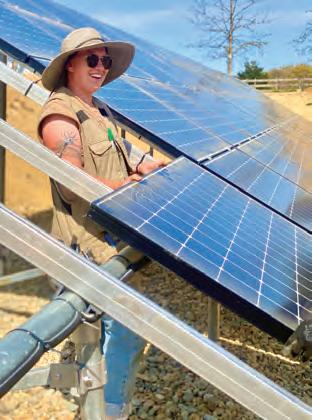
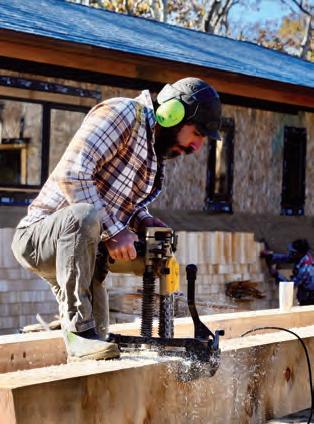
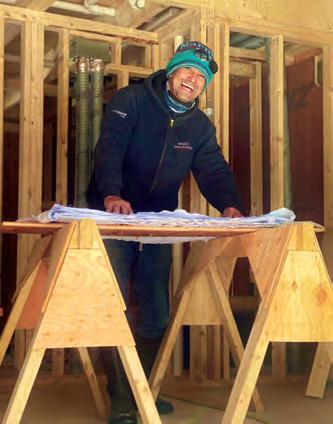
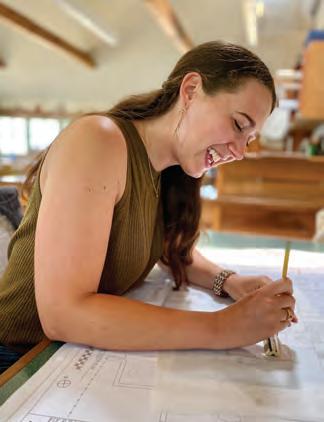

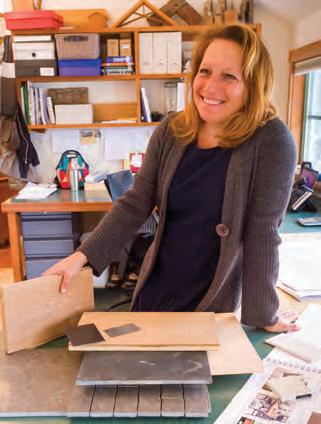
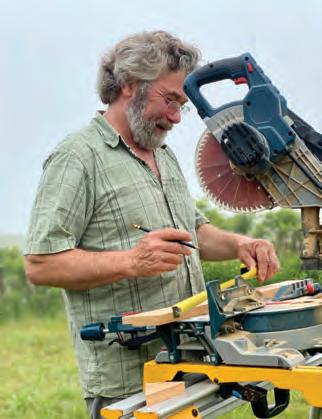
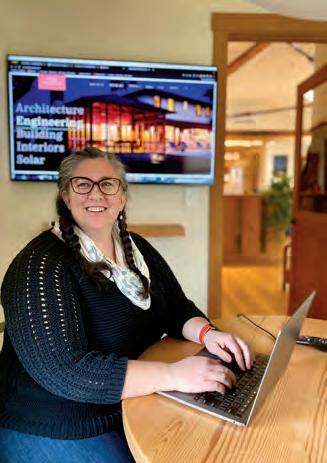

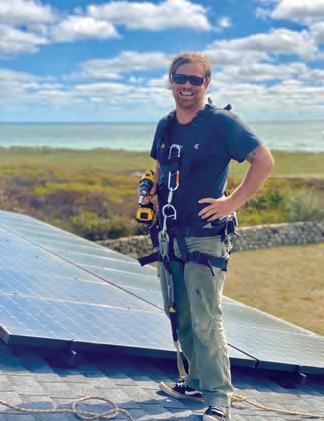
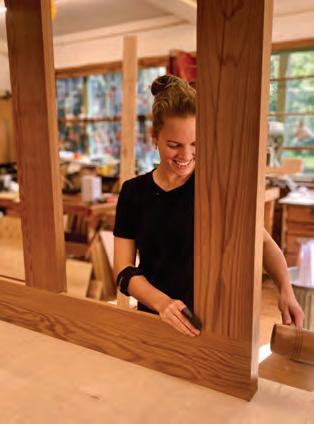
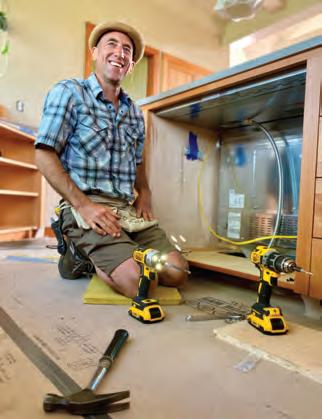
We love our work. We make sure you do too. ARCHITECTURE • ENGINEERING BUILDING • INTERIORS • SOLAR SOUTHMOUNTAIN.COM
SPRING POINT WATERFRONT PARADISE

Stunning Chilmark four-acre waterfront paradise. The spacious main house and guest house enjoy wonderful sunsets and unique privacy nestled between a gentle hill and a 200-acre private estate. The property is in the highly desirable Spring Point community with three quarters of a mile of private beach, endless dirt roads, walking trails, and two tennis courts. Exclusively offered $11,995,000.
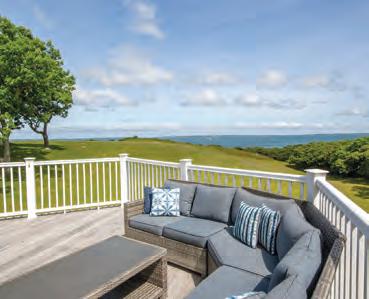

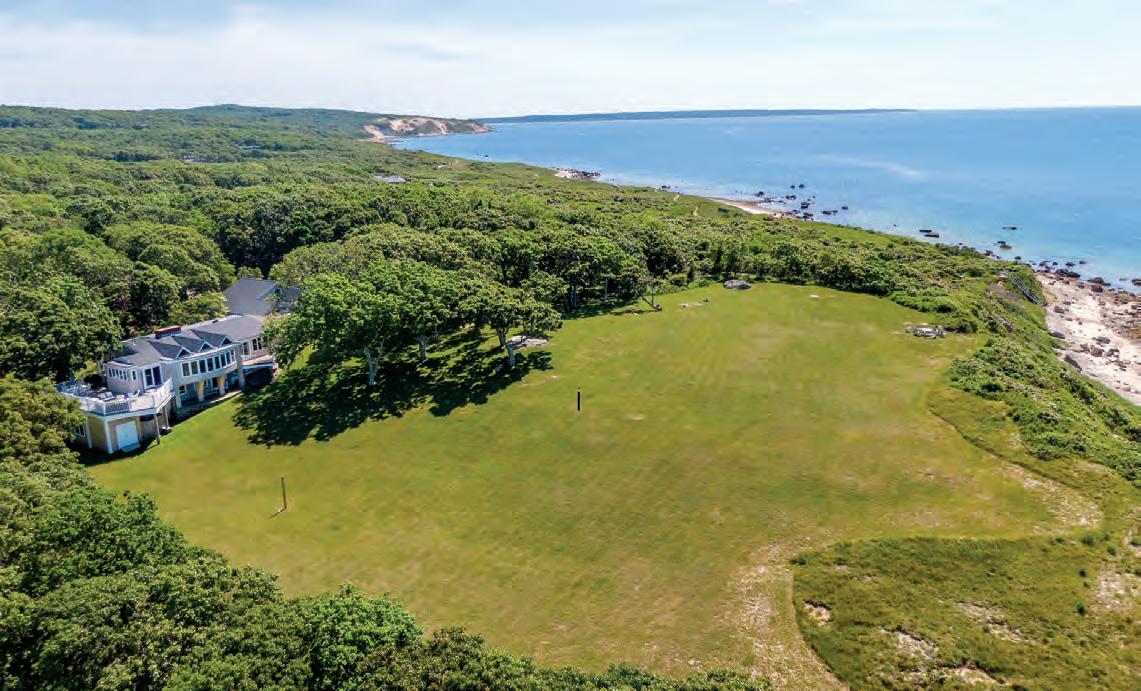

An Independent Firm Specializing in Choice Properties for 50 Years 504 State Road, West Tisbury MA 02575 Beetlebung Corner, Chilmark MA 02535 www.tealaneassociates.com
508.645.2628 Chilmark
508.696.9999 West Tisbury
ohDEER offers you and your family a proven and safe solution to control ticks and mosquitoes so that you can enjoy your yard. Our products are true all-natural repellents that contain no pesticides or chemicals of any kind.


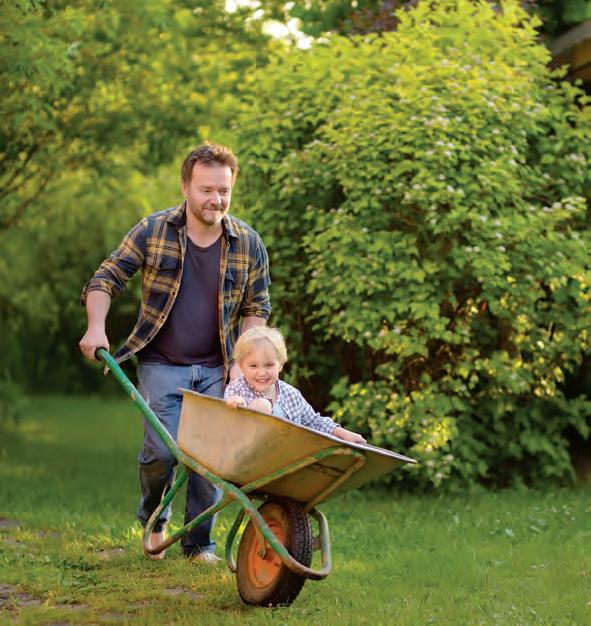
Publisher and Co-founder Victoria Riskin
Editors Leslie Garrett, Jamie Kageleiry editor@bluedotliving.com
Digital Projects Manager Kelsey Perrett
Associate Editor/Reporter Lily Olsen
Summer Interns Julia Cooper, Cleo Carney
Contributing Editors Mollie Doyle, Catherine Walthers
Creative Director Tara Kenny
Design/Production Sophie Petkus
Proofreader Irene Ziebarth
Ad Sales Jenna Lambert adsales@mvtimes.com
Anne Kelley anne@bluedotliving.com
Corporate/Non-Profit Relations Meghan Burke meghan@bluedotliving.com
Digital Media Consultants Ray Pearce
Contributors, this issue Randi Baird, Geoff Currier, Mollie Doyle, Jeremy Driesen, Sheny Leon, Anne Mazar, Gwyn McAllister, Sam Moore, Catherine Walthers
Bluedot, Inc. Co-Founders Walt and Nora McGraw
Bluedot and Bluedot Living logos and wordmarks are trademarks of Bluedot, Inc. Copyright © 2022. All rights reserved.
Bluedot Living: At Home on Earth is printed on recycled material, using soy-based ink, in the U.S.
Bluedot Living magazine, published quarterly, is distributed by The Martha’s Vineyard Times. Find it free at The MVTimes, newsstands, select retail locations, inns, and hotels.
Visit the digital version of this magazine at marthasvineyard.bluedotliving.com
See our new national website at bluedotliving.com
Sign up for our biweekly newsletter here: bit.ly/Bluedot-newsletter
Find Bluedot Living on Twitter, Instagram, and Facebook @bluedotliving
Subscribe: Please inquire at mvtsubscriptions@mvtimes.com

2 MARTHA’S VINEYARD /SUMMER 2022
BDL • OUR TEAM
• • • • • • DEER, TICK & MOSQUITO CONTROL!
| MV@oh-DEER.com oh-DEER.com/locations/MV
SAFE FOR YOU, YOUR FAMILY & PETS! • KILLS TICKS & MOSQUITOS ON CONTACT. • AN EFFECTIVE ‘GREEN’ ALTERNATIVE TO PESTICIDES & CHEMICALS CALL US! 508.627.2928
(508)627-2928
•
ENJOY MORE TIME OUTSIDE! “
again at that dot. That’s here. That’s home. On it everyone you love .” –Carl Sagan
Look
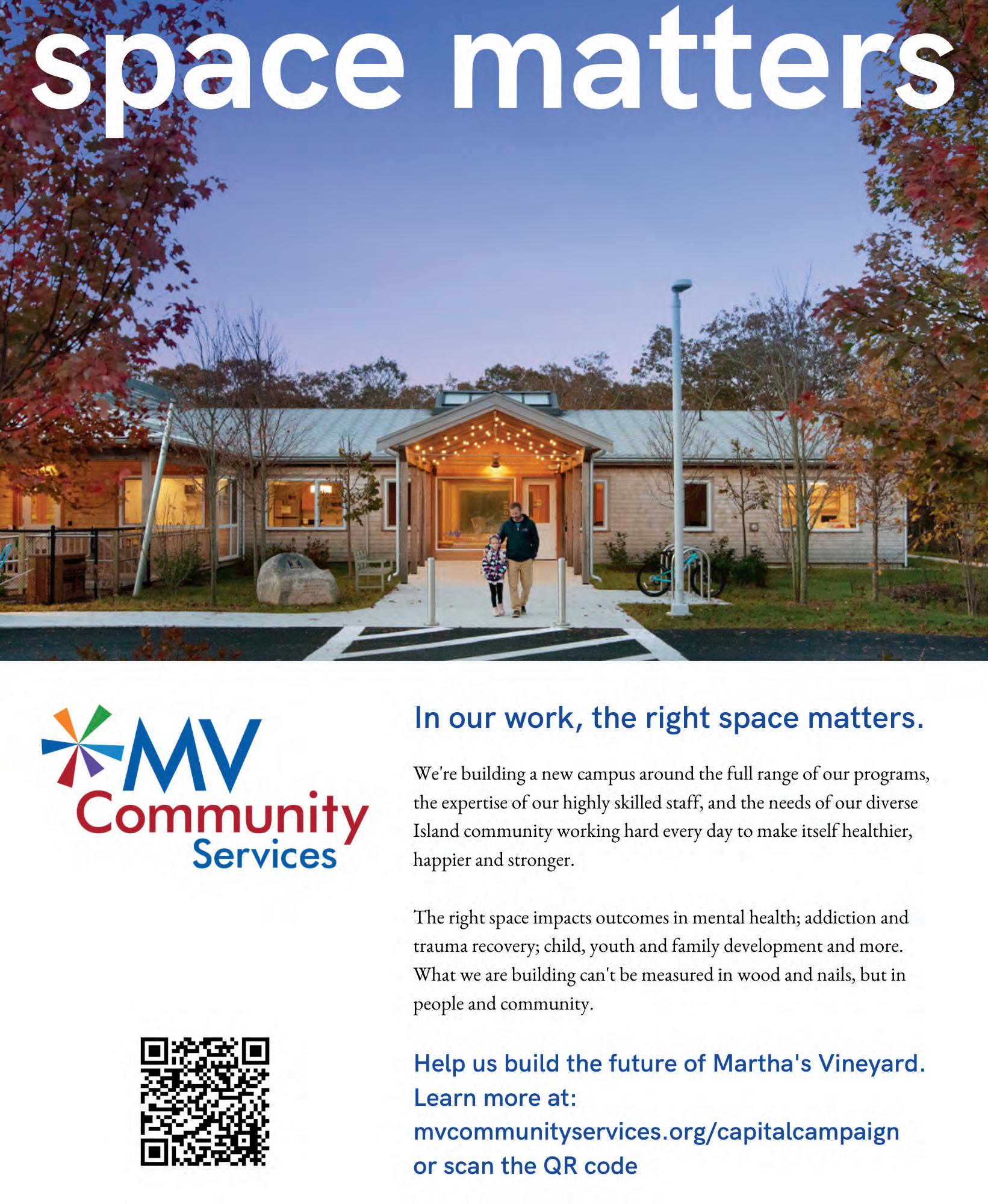
3 marthasvineyard. .com
Dear Bluedot Living Readers,


AFor a relative newcomer to Martha’s Vineyard it’s the ocean that dazzles. But spend any time here and you’ll realize that, to longtime Islanders, the real jewels are the ponds. They often come with multisyllabic names that speak of history. And, as writer Sam Moore makes clear in his beautiful story on page 38 of this issue, they hold entire worlds or, as he puts it about one of the ponds: “Its coves reach like fingers northward, their pinched ends holding still water. Home to osprey, otter, eelgrass, artist. Site of Island rituals: the opening of the cut, the catching of the bass, the long walk to the beach.”
A huge thank-you to the Island artists whose work accompanies and animates Sam’s story (and our cover!).
Gratitude to Martha’s Vineyard Bank for sponsoring this extended section, “The Art of the Great Ponds.” Their exhibit of Island Great Pond artists, curated by Monina von Opel (the force behind the Martha’s Vineyard Hospital’s Permanent Art Collection), opens August 12 at the bank’s Chilmark branch, and runs to September 1. There will be an opening (with wine and cheese) on August 12 at 5:30 pm, with Ollie Becker speaking and showing clips from his great ponds documentary film.

Shoutout to all the advertisers who continue to support Bluedot Living’s determination to deliver relevant and interesting stories.

Thank you as well to our young summer interns. Cleo Carney and Julia Cooper have infected all of us with their enthusiasm for the work in front of us.
And finally you, our readers, who share your own stories with us, ask us probing questions, and enjoy Bluedot in its many forms — print magazine, newsletter, our Martha’s Vineyard site (marthasvineyard.bluedotliving), and our new national site (bluedotliving.com). If you enjoy the recipes, the “Buy Better” marketplace, the advice, and the dispatches from all over, sign up for our national newsletter at bluedotliving. com/newsletter/


In the meantime … dive in.
– Leslie Garrett and Jamie Kageleiry


4 MARTHA’S VINEYARD /SUMMER 2022 EDITORS' LETTER
green contractors of martha’s vineyard 508.696.3120 • nmdgreen.com • INFO@nmdgreen.com Plumbing • Heating • Air Conditioning Water Treatment • Maintenance Programs INSTALlATION & SERVICE GREeN SERVICE Geo Thermal • Solar Hot Water • Heat Pumps Energy Management • Design & Consultation Digital Control Systems
Johnny Hoy takes a boat ride in the pond, Colin Ruel. Ruelgallery.com, open Tues. – Sun., 11-5
The. Hub.
A New Bluedot Living Newsletter

Launching Late August
Our new ‘Hub’ website and newsletter will feature even more Simple, Smart, Sustainable Stories — from all over.
ADVICE
Questions and answers for everyday eco-friendly living.

DISPATCHES
On-the-ground reporting highlighting a universe of ideas and changemakers.
MARKETPLACE
Strive to buy less, but when you do buy — buy better.
FOOD
Clean-cooking recipes and sustainable tips and tricks for buying and storing food.
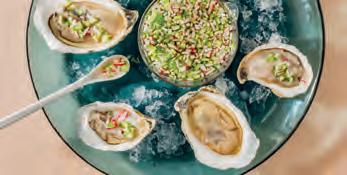

SIGN UP HERE
Sign up for The Hub newsletter for a chance to be our next big winner!
bluedotliving.com/newsletter
marthasvineyard. .com


5
DISCOVER
Meet Bruce Nevin of Edgartown, dining with his family at Atria. Bruce won our last $200 drawing.
38 The Art and Life of Martha's Vineyard's Great Ponds
By Sam Moore
A dive into (and celebration of) the Island’s Great Ponds. (Can you name them all?)
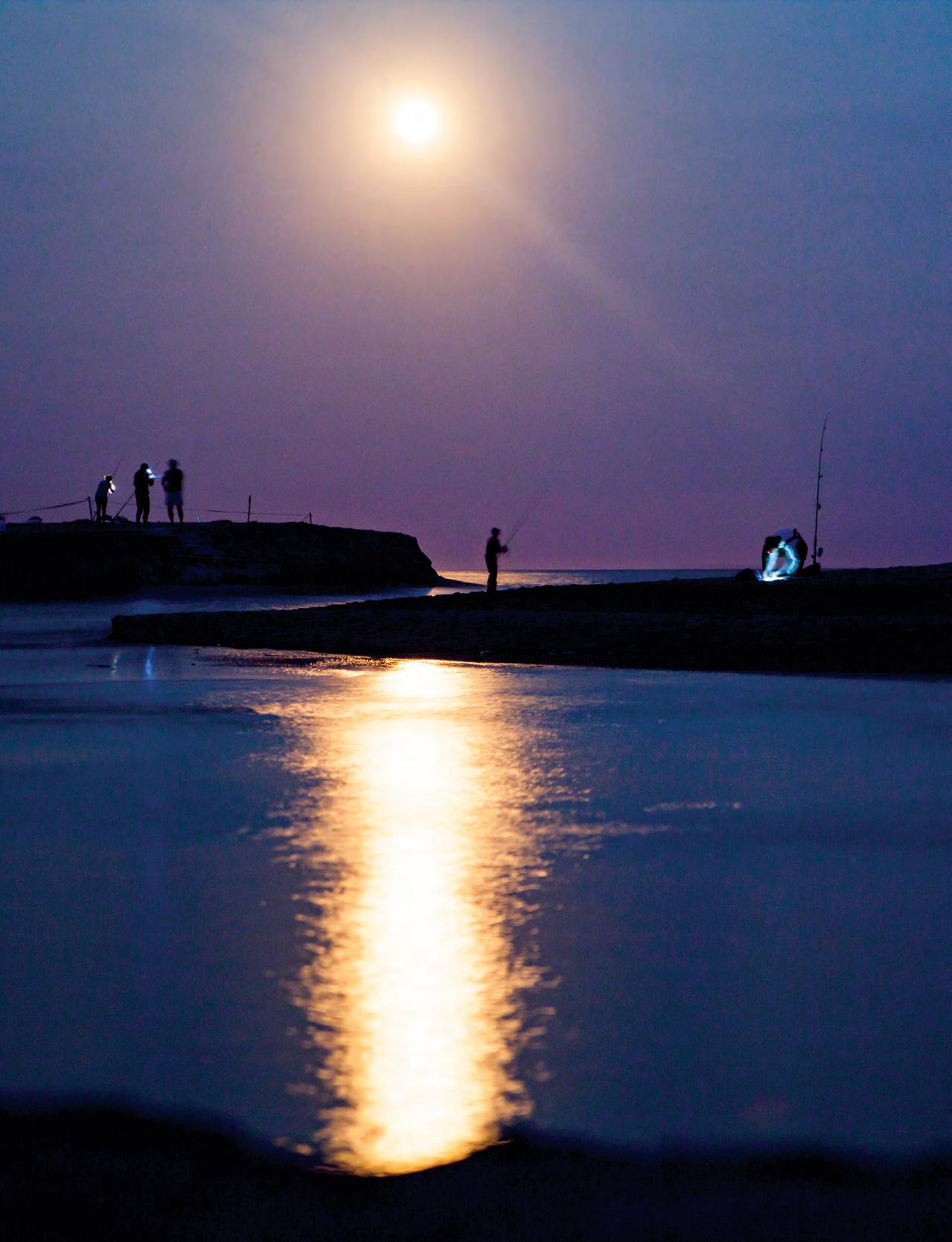
60 Essay: Lawn and Disorder
By Leslie Garrett
Can a couple — one pro-lawn, one anti — achieve a green new deal?
Departments
18 Dear Dot Our eco-advice columnist responds: Can I compost my beef? And what the heck do I do with all my plastic bags?
20 Field Note: Biodiversity Works’ Matt Pelikan takes us on a BioBlitz and catches us up on the MV Atlas of Life.
22 Cruising with Currier
Ride along with Geoff Currier in Climate Week’s electric vehicle convoy!

52 Right at Home
By Mollie Doyle
The Sun People of Vineyard Haven — Meet the Solarazzas, a couple (very) committed to solar power.
58 Room for Change: The Yard
Sure it’s green but is it green? Mollie Doyle walks the yard less mowed ...
63 The 'Keep This' Handbook
Your eco-guide to composting, recycling, volunteering, activism, and more.
48 Local Heroes: We nominate Tess Bramhall and Pam Goff — two women dedicated to land preservation on the Vineyard.
Cover image; After the Rain, 2022, by Hannah Moore “This painting is inspired by that moment after a much needed rain storm, when the sun shines through the last of the mist and everything feels activated and lush. It features a snowy egret, least flycatchers, and a ruby-throated hummingbird.” See more of Hannah’s work at the Moore Family Gallery: 11 Martha’s Park Road, Oak Bluffs. moorefamilygallery.com
6 MARTHA’S VINEYARD /SUMMER 2022
4 Editors' Letter 8 What.On.Earth. These storm stats will blow you away 9 Good News from MV and All Over 10 Favorite Things: Bluedot staff share their summer eco-reads — fiction, poetry, non-fiction, and a couple of can’t-miss documentary films 12 Climate Action Fund: Dedicate tax-sheltered donations to climate projects 13 Buy Local: Maggie’s Salon in Vineyard Haven is cleaning up 14 Buy Better: A chocolate company and paper studio right on-Island 16 In a Word: ‘Micromobility’ Features 16 Weed Wisdom By Cathy Walthers Rebecca Gilbert says that weeds are plants that have survived a lot of adversity. Maybe they can teach us a thing or two + recipes. 30 “The Things They Carried” By Kelsey Perrett Cindy Kane’s latest art installation unpacks the baggage of climate change. 34 Pavement: What's So Bad About It, Anyway? By Leslie Garrett Reimagining our paved spaces can help reduce urban heat, and build community, too. Find Us! Sign up for our biweekly Martha's Vineyard Bluedot newsletter: bit.ly/ Bluedot-newsletter Find our website at marthasvineyard. bluedotliving.com
CONTENTS Upfront
PHOTO BY SAM MOORE
OPENING


Friday, August 12 5:30 pm















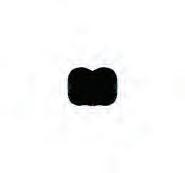
MV Bank Chilmark Branch, 517 South Road, Chilmark

Sponsored
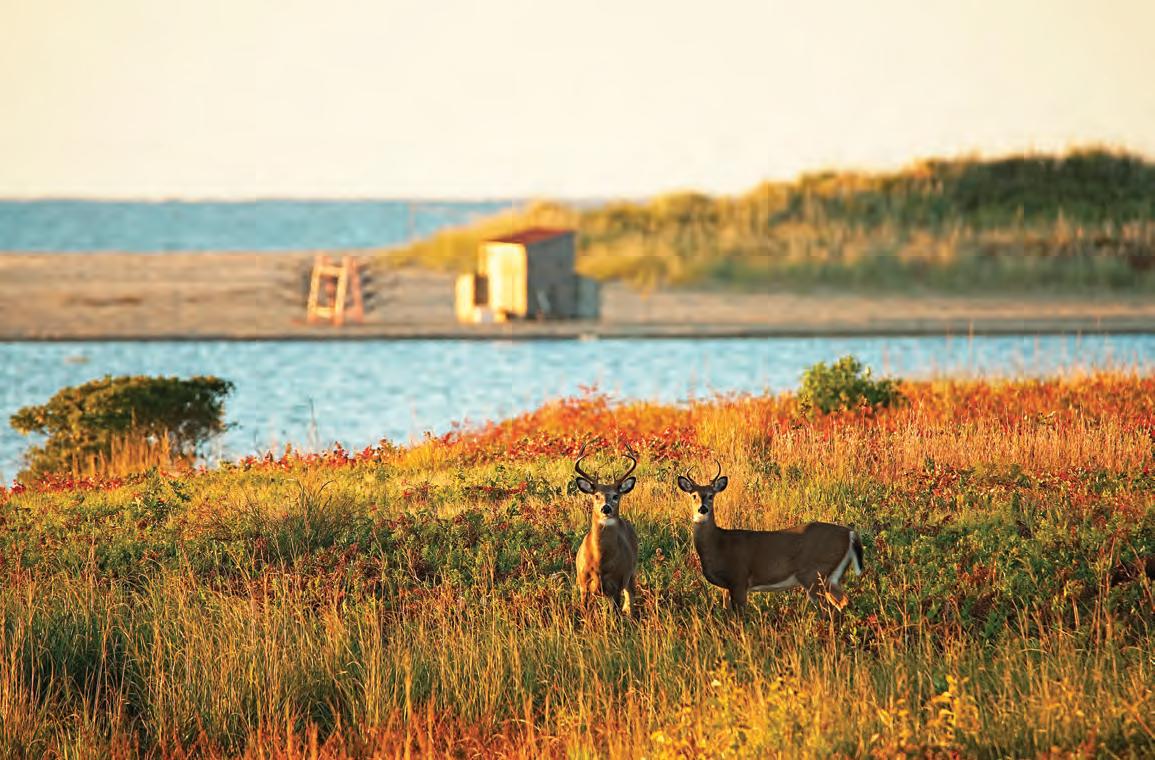
BDL 7 marthasvineyard. .com www.mvbuyeragents.com 508-627-5177 Email: buymv@mvbuyeragents.com 13 Coffins Field Road Edgartown, MA 02539-1661 “And, when you want something, all the universe conspires in helping you to achieve it.” — Paulo Coelho, The Alchemist You’re Invited! The Art of the Great Ponds
Courtesy MV Hospital Permanent Art collection Featuring Island Artists from the Martha’s Vineyard Hospital Permanent Art Collection, curated by Monina von Opel HELP PROTECT WHAT WE TREASURE With “Great Ponds” film excerpts and remarks by the filmmaker, Ollie Becker
Woodcut, “Menemsha” by Robert S. Siffert,
· For more info: bit.ly/Great-Ponds-Art-event
by Martha’s Vineyard Bank
RECEPTION
What.On.Earth.
STORM SURGE

–Barack Obama, June 25, 2013, addressing students at Georgetown University
1. Number of weather and climate disasters in the U.S. with losses exceeding $1 billion from 2019 through 20211: 56
2. Total approximate cost of damages from weather and climate disasters in the U.S. from 1980 to 2021: $2.155 trillion
3. Average annual number of weather and climate disasters from 2017 to 2021 in the U.S.: 17.2
4. Average cost of hurricane or tropical cyclone between 1980 and 2021: $20.5 billion
5. Speed of world’s strongest recorded wind gust (excluding tornadoes), Australia, April 10, 1996: 253 mph
6. Where Massachusetts sits in a list of 19 states with the highest storm surge risk: 10
7. Where Florida sits in a list of 19 states with the highest storm surge risk: 1
8. Odds of being attacked by a shark in the US: 1 in 3.75 million
9. Odds of being struck by lightning in the US: 1 in 1.2 million
10. Percentage of Americans who don’t have an emergency plan: 36*
11. Number of lives saved annually from storm shelters and emergency plans: ~10,000
*Those of us in Dukes County are among the 64% of Americans who do have an emergency plan, thanks to the disaster response team. You can find out what that entails at mvdisasterresponse.org.
Artist Mary Drake Coles captured Edgartown after the 1944 hurricane. Coles's work is in the collection of the Martha's Vineyard Museum.
WHAT ON EARTH 8 MARTHA’S VINEYARD /SUMMER 2022
1–4: NOAA Office for Coastal Management; 6–7: Weather Underground; 5. The Weather Network; 6–7: Insurance Information Institute; 8–9: The Balance; 10–11: Texas Tech University.
“Sticking your head in the sand might make you feel safer, but it’s not going to protect you from the coming storm.”
good news
FROM ALL OVER
New York computers live on
Yet another phone bites the dust, and it’s time to fork out a pretty penny to replace it. As consumers go through dozens of electronics in their lifetimes, it not only has an impact on their wallets but on the environment. A new bill passed by the New York state legislature in June, however, will change this. The Digital Fair Repair Act will require tech companies to sell repair parts and provide instructions that could be used by independent repair shops or by consumers to fix their electronics themselves.
Tech companies have long made it difficult to repair electronic devices through lobbying efforts and making the necessary replacement parts difficult to buy. Tech waste is a serious problem, as every new device has a carbon footprint. Apple emitted about 16 million metric tons of CO₂ to the atmosphere last year through product manufacturing. Recycling rates for electronic waste are also pretty low, so as consumers go through excess amounts of devices there is preventable waste sitting in landfills. And electronics contain toxic chemicals that can leach into the environment. New York is the first state in the country to pass such legislation, but with repair parts and guides more widely available in New York, their circulation to other states is likely.
Ambitious Mass. climate goals
On June 30, the same day that the Supreme Court dealt a blow to the EPA’s authority, Massachusetts’ Office of Energy and Environmental Affairs released a plan to slash greenhouse gas (GHG) emission to 50% by 2030 relative to 1990 levels. Massachusetts also maintains the goal of achieving net-zero emissions by 2050.
The strategy will include expanding offshore wind and solar power, supporting the transition to electric vehicles, and revamping buildings with electric heat pumps. The plan will also focus on protecting those most impacted by the effects of pollution and climate change. These changes could save the average Massachusetts household $400/year in utility bills and create roughly 22,000 new jobs, according to state estimates.
In a press release, House Speaker Ronald Mariano said, “This landmark legislation will set Massachusetts on the path to net-zero emissions by 2050 and, in the process, help make Massachusetts a leader of the clean energy future.” Though the goals are set high, Massachusetts is well on its way, with GHG emissions already 31.4% lower than they were in 1990.
For more good news, and dispatches from all over, visit our national Bluedot Living site: bit.ly/BDL-GOOD-NEWS

UPFRONT • GOOD NEWS 9 marthasvineyard. .com
FAVORITE THINGS:
Reading in a hammock, reading in a beach chair, reading on a porch swing, reading in bed: Summer offers loads of options to dive into a great book. For those seeking out climate books of all genres, take a page out of our recommendations! And please, support your local bookstore (and library).
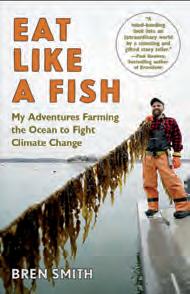
Julia Cooper, Bluedot’s digital intern (and wine expert) is reading Family of Origin by CJ Hauser and says, “It’s a terrific novel by an undergrad professor of mine that takes place in a world where a group of scientists have become obsessed with a case study that they claim proves evolution has started running in reverse. A heartwarming and engaging read about family, loss, nature, and progress. I’m not always a huge fiction reader, but I was gripped by this from beginning to end.

I’m also reading Wine, Unfiltered by Katherine Clary, which is an approachable and astoundingly informative intro to the contemporary natural wine movement. Clary focuses on the positive, sustainable choices being made by small-production, low-inter-
vention natural wine makers rather than inundating the reader with disappointing (and often disgusting) facts about the artificial and destructive practices used in conventional mass-market wine production. A quick read and an essential one for anyone who wants to better understand wine as an agricultural product and become a more eco-conscious consumer.”

Bluedot digital consultant Ray Pearce is reading Eat Like A Fish by Bren Smith. “A well-written story of a longtime commercial fisherman (Smith) who starts with an oyster farm and evolves into one of the leaders in Regenerative Ocean Farming. He has a wonderful, down-to-earth voice and was simply looking to make a living launching his oyster farm and it evolved from there. Living on an Island, with both an appreciation for the career opportunities ocean farming can present as well as the environmental benefits, this book truly resonated with me. It was a James Beard Award winner as well.”
Columnist Geoff Currier says that, “In a ‘Cruising with Currier’ column I did with Jed Katch, he turned me on to the
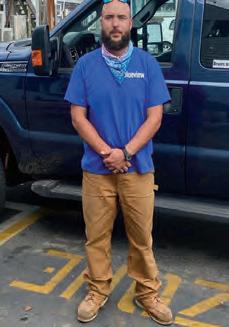
Interested in making your yard a haven for pollinators, birds, and other wildlife? Join the Natural Neighbors network! Angela Luckey will work with you to develop manageable strategies to contribute to the ecological health of the island and encourage a greater sense of community around creating backyard habitat.




To sign up for this free program email Angela at angelal@biodiversityworksmv.org


10 MARTHA’S VINEYARD /SUMMER 2022
Natural Neighbors Program BLUEVIEW GUTTERS Seamless Aluminum, Copper, Fiberglass, Wood Installation, Repairs, Seasonal & Yearly Cleaning Joseph Cogliano 774-563-0938 FREE ESTIMATES CALL FAVORITE THINGS
BLUEDOT’S FIRST ANNUAL ECO-READS
work of Suzanne Simard, a professor of forest ecology at the University of British Columbia. In her book Finding The Mother Tree: Discovering the Wisdom of the Forest, she writes that the trees in a forest are often linked to each other via an older tree she calls a Mother Tree that uses a special kind of fungus — called a mycorrhizal fungus — to reach out and communicate with other trees. What’s more, she writes, we can use this fungus to identify the Mother Trees so we’ll know not to destroy them, which can help to perpetuate the health of the forest. Fascinating.”


Kelsey Perrett, digital projects manager, is reading Karen Russell's short stories, especially The Gondoliers,The Tornado Auction,The Ghost Birds and says, “I’ll devour anything Karen Russell writes. She has an effortless way of incorporating the emotional core of climate issues into stories that are on the surface absurd or fantastical. They’re appropriately grim, but they’re not doomsday prophecies or survival stories. They’re stories about adaptation — people grappling with their environment, their relationships, and their choices in a changing world. “We’re going to have to learn another way,” Russell told The Rumpus. “I thought if we could adapt the world in these dark ways, there’s a sort of dark optimism embedded into this knowledge of the future.”
Bluedot founder (and former film producer) Vicki Riskin urges all of us to take a look at award-winning documentary To Which We Belong, which, she says, “follows several younger-generation ranchers and farmers as they return to their family homes to make the family businesses, teetering on the brink of collapse, profitable again. Their plan, and their families’ last best hope, is to employ new and innovative farming techniques, which hold exciting possibilities. For generations, their families have worked their lands to near-death with chemicals and modern industrial farming techniques to wring a living from their increasingly unyielding land. Now, as worn as their overused land, the older generation is willing to hand off the businesses to their children — uncertainly, skeptically, but also prayerfully and gratefully. For each family, this major turning point requires courage, hard work, trust, and love. The rewards are astounding. The restoration of the land to its natural vitality and bounty. Beauty. Cost-savings. Impressive profits for the first time in years. And throughout, a moving sense of families united. Be prepared for tears — theirs and your own.”

For more staff eco-reads, visit bit.ly/mvbdl-Favorite-things

FAVORITE THINGS 11 marthasvineyard. .com
Local DONATE TO LOCAL CLIMATE PROJECTS VIA
THE CLIMATE ACTION FUND
While parts of this country experience record heat waves, nations throughout the world are beset by dangerously soaring temperatures, and President Biden is struggling to advance his environmental agenda, an organization on the Island has been working on solutions that can be implemented locally to fight climate change.
The Climate Action Task Force (CATF) has emerged as an arm of the Martha’s Vineyard Commission (MVC) to respond to the challenges of climate change on our Island. Two years ago, the MVC hired Liz Durkee as its first climate change planner. As a result of her work and that of others, the state granted the MVC and CATF $173,834 to create a Climate Action Plan (CAP). (See Bluedot’s conversation with Liz Durkee about the CAP here: bit.ly/mv-cap.) More than 100
Islanders worked on the CAP to identify goals and actions needed to address the impacts that climate change is having or is projected to have on our Island.
The Martha’s Vineyard Community Foundation (formerly known as the Permanent Endowment) agreed to support a new Climate Action Fund under its nonprofit 501c3 status. Individuals and businesses can now donate tax-sheltered funds via the MVCF that they want to earmark for climate research projects that the CAP has slated; funds could even be used for climate emergencies.
The Climate Action Fund has already joined forces with the Woodwell Climate Research Center to help raise funds to identify the relationship between climate change and carbon sequestration. The joint venture has raised $400,000 of the $600,000 needed to complete the project.
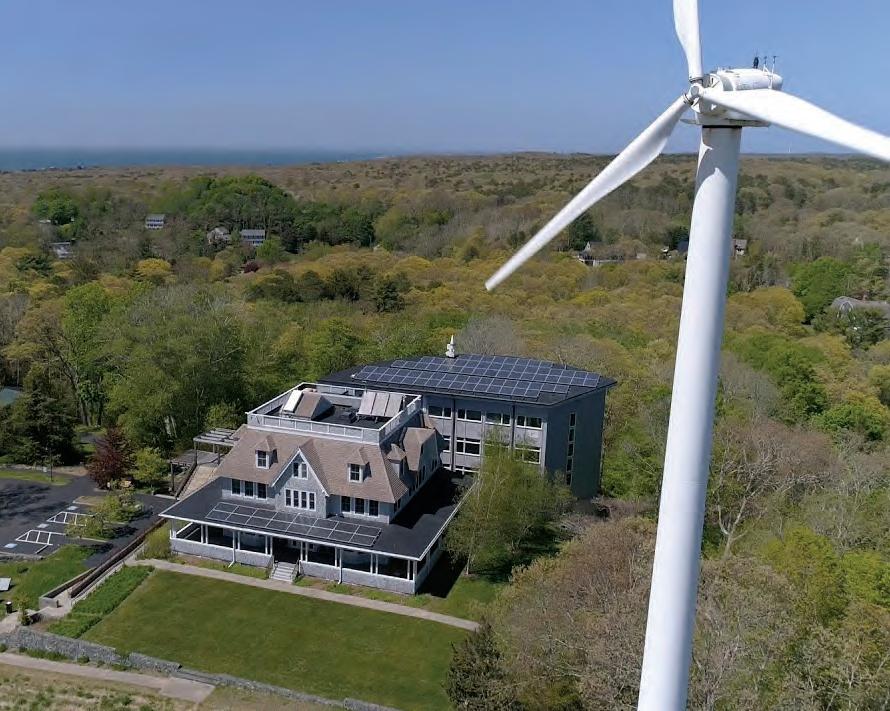
A second project, to be done in concert with Nantucket, is a study of carrying capacity by the U.S. Army Corps of Engineers. The study will look at our water supply, septic and waste challenges, traffic issues, the health of our water bodies, and other indicators that speak to the health and future of our islands and our ability to absorb impacts from people, cars, and development.
“Going forward there will be times the Vineyard will need to add matching funds in order to secure grants,” Kathy Newman, the Aquinnah representative to the Martha’s Vineyard Commission’s Climate Action Network, said. “Hopefully there will be infrastructure and climate change money for remedying fragile areas before they reach emergency status. We want to be ready and able to act when the need arises.
“This Island has so much energy, such good values, and such pride in its beauty and community. If there is a place that can bring it all together and work proactively on climate issues, Martha’s Vineyard is the place.”
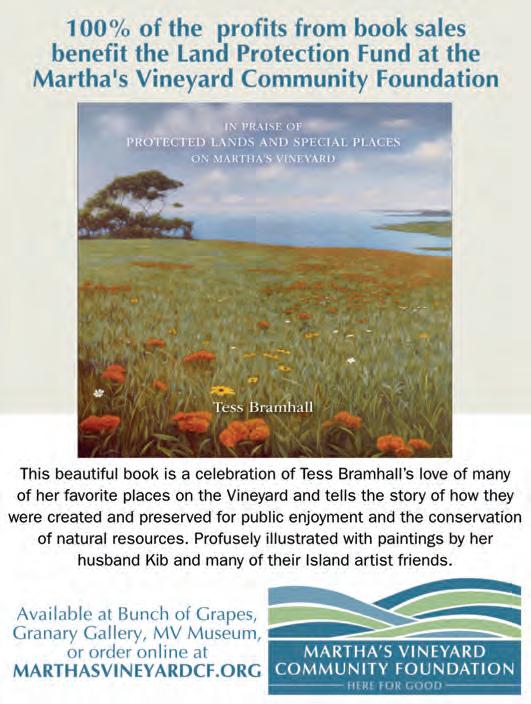
To contribute to the Climate Action Fund, go to bit.ly/ MVCF-CAF and scroll down to “Non Endowed Grant Funds” and select Climate Action Fund.
– Gwyn McAllister
CLIMATE PROJECT • LOCAL 12 MARTHA’S VINEYARD /SUMMER 2022
dolest, dolorep eos voluptio sapero voluptio sapero
Woodwell Climate Research Center, Woods Hole.
COURTESY WOODWELL CLIMATE RESEARCH CENTER
HAIR CARE THAT CARES
Every minute, the beauty industry in North America sends 877 pounds of waste to the landfill
Over the course of a day, salons in the U.S. throw away
63,000 pounds of hair clippings
110,000 pounds of used metal
42,000 pounds of excess hair dye
By partnering with Green Circle Salons, Maggie’s Salon in Vineyard Haven is taking action to reduce this staggering amount of waste. If you can’t get to Maggie’s Salon, you can find a Green Circle Salon at bit.ly/Green-circle.


Green Circle Salons is streamlining recycling processes in the beauty industry. Through their recycling program, salons are able to reduce their total waste by 95% — this waste includes hair clippings, excess hair product, used foils, plastic containers, cotton swabs, nail files, waxing strips, and PPE. Since beginning their work in 2009, Green Circle Salons has kept nearly nine million pounds of beauty waste out of landfills. Green Circle Salons’ recycling program also prevents the harsh chemicals often used in salons from entering our waterways when excess product is rinsed down the drain.
What will become of the products Maggie’s Salon recycles through Green Circle Salons? Most will be recycled: Plastics will become new containers, cardboard and paper will be turned into cellulose to use as insulation, and metals will be melted into sheets and bars that can be used to produce bicycles. Hair dye will be separated into water and oil with the water being cleaned and returning to the water system and the oil being blended into clean fuel solutions. Singleuse items like cotton swabs and PPE will be used in a waste-to-energy process to create renewable energy with the leftover ash to be used as a filler in construction materials. As a certified Green Circle Salon, Maggie’s Salon is working toward carbon-neutrality, meaning the amount of carbon their business emits into the atmosphere is offset by their waste-reduction efforts.
–Julia Cooper


LOCAL • HAIR CARE THAT CARES 13 marthasvineyard. .com
OPEN FOR DINNER TUESDAY ~ SUNDAYS FROM 5-10 CLOSED MONDAYS ATRIAMV.COM · 508-627-5850 Your Renewable Energy Solution Solar, plus smart, safe and long-lasting battery technology. Power your home with clean energy around the clock with solar and batteries. www.fullers.energy 508.696.3006 info@fullersenergy.com
Buy Less, but Buy Better
By Gwyn McAllister Photos Courtesy of the Artists
of the paper-making process, traveling to remote areas of Burma (Myanmar), China, and Tibet to study techniques, as well as history and plant origins.
She shares what she has learned throughout the three decades that she has been making and selling paper with students at her West Tisbury studio. Those interested can take classes in papermaking, book binding, painting with wet pulp, paper marbling, and a host of other options.
At the conclusion of the basic papermaking class, students will bring home an assortment of beautiful sheets and note cards decorated with embedded wildflowers. What better way to add a really personal touch to a note to a friend or invitations to a special event.
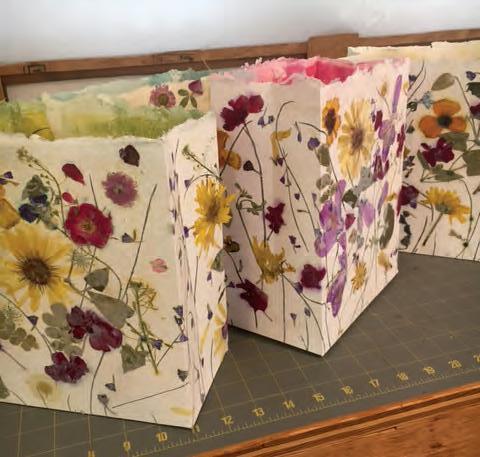
“When you’re pulling paper it’s a very Zen thing,” Bernat says. As she writes on her website, “There is poetry in the papermaking process and a spiritual attraction to paper itself. To form a sheet of paper by hand stirs and preserves ancient connections with our past.”
Seastone Papers’ studio is located at 53 Christiantown Road, West Tisbury and is open year round by appointment by calling 508-693-5786.
Seastone Paper products can also be found at the West Tisbury Farmers Market at the Agricultural Society Hall on State Road, West Tisbury on Saturdays from 9 a.m. to noon.
seastonepapers.com
– Gwyn McAllister
Seastone Papers
While some may think that paper has become all but superfluous in this age of electronic communication, Sandy Bernat would beg to differ. She’s found that she has no shortage of customers for Seastone Papers — the beautiful handmade paper products that she sells at the weekly Farmer’s Market at the Ag Hall.
Along with stationery and cards, Bernat offers journals, blank books, and decorative sculptural paper bags that can be used for gift bags, vessels for dried flower arrangements, or luminarias. The lovely small bags, decorated with a splash of pressed wildflowers, have proven so popular, Bernat inevitably sells out every week.
Not only do Seastone products have a rustic appeal, her paper and paper products are about as organic as you can get. Bernat creates all of her papers using a variety of plant materials — many of them grown on the Island — such as corn husks, gladiola, iris and daffodil leaves, and various wild grasses, including phragmites — a wildly invasive species. More recently she has started working with seaweed.
Other materials that Bernat draws from include discarded denim, cotton T-shirts, and linen tablecloths. She also purchases raw cotton and a couple of imported plant products like Abaca banana fiber and Kozo, which comes from the bark of mulberry trees.
To say that Bernat is enthusiastic about paper would be an understatement. She has conducted extensive research on all areas
Salt Rock Chocolates
There’s chocolate and then there’s … chocolate. Case in point, Salt Rock Chocolate Co., based out of Chilmark, has earned a dedicated — even obsessed — following since its launch in 2020. The handmade chocolates can only be found at the Farmers Market on

BUY LESS/BUY BETTER • UPFRONT 14 MARTHA’S VINEYARD /SUMMER 2022
Wednesdays and Saturdays and you had better get there early if you want to score a pound (or two or three) of the delectable chocolates, which come in both traditional and some unique variations.
The premium chocolate company aims to produce a quality product while also maintaining as small an environmental footprint as possible. The co-owners, sisters Ali and Sarah Flanders, source local ingredients when possible and strive to keep waste production to a minimum.

Among the local or regional suppliers that the sisters draw from are Chilmark Coffee Company (for the Chilmark Coffee Crunch); Ghost Island Farm (for Great Rock Bite with hot pepper lantern spice); Salterione Sea Salt, a women-owned business based in Duxbury; and Curio Spice of Cambridge, whose unique blend of florals and exotics lends an interesting twist to Salt Rock’s white chocolate
Chilmark Fleur.
Salt Rock Chocolates was launched in 2020 when the Flanders sisters, who along with much of the community, were mourning the loss of the beloved Chilmark Chocolates, which closed its doors at the end of 2019. Ali and Sarah had both worked for the renowned chocolatier, which was located next door to the tiny cottage they shared with their mother, Joy. After exploring other individual career options off-Island, the two sisters returned to Chilmark where they had grown up and decided to join forces to establish their own small business. The sisters have replicated some of their predecessor’s classic recipes such as the ABC (Almond Butter Crunch) and chocolate dipped cranberries, while adding their own twist with some unique options, like the aforementioned Chilmark Fleur with crystalized ginger and notes of Hibiscus, pink pepper, anise, fennel, rose petals, coriander, spearmint, cardamom lavender, and ylang ylang.
As they write on their website, “Our chocolates are influenced by the colors and tastes of the island we grew up on. We love the process of hand-making each chocolate and are excited to share it with you!”
saltrockchocolate.com
 –Gwyn McAllister
–Gwyn McAllister

Want to see more (and more off-Island) “Buy Betters”? Sign up for our soon-to-be-launched Hub Newsletter (with a robust Buy Better Marketplace) at bluedotliving.com/newsletter

The choices we make as an Island community over the next few years will shape the fate of our waters for generations.
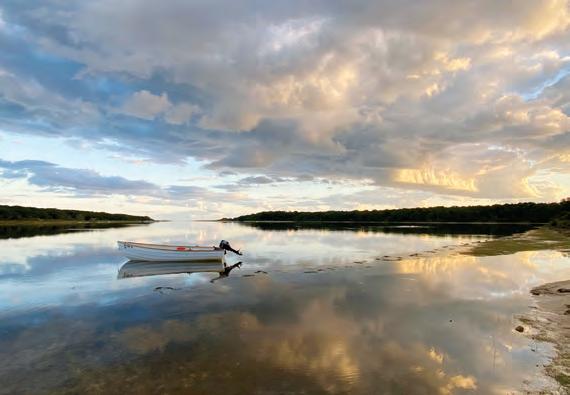
· Water Quality
· Pond Biodiversity
· Pond Opening Info
· Eelgrass Ecosystems
· Blue Carbon & Climate Change
Cyanobacteria, a.k.a. blue-green algae, are a group of microorganisms found in all Vineyard waters. When cyanobacteria bloom, they can produce cyanotoxins, which when concentrated, can cause adverse health effects in humans, pets, or livestock who wade in or ingest blooming waters.

See current conditions by visiting greatpondfoundation.org/mvcyano
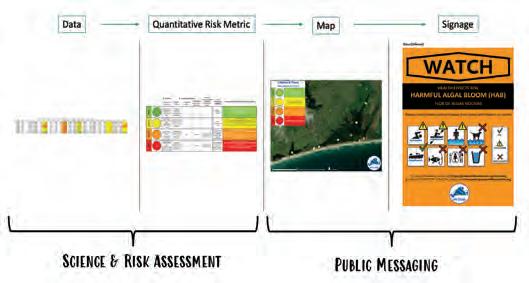
UPFRONT • BUY LESS/BUY BETTER 15 marthasvineyard. .com
join the
in our efforts to restore the ecological health of our
through scientifically informed management, public education, and community collaboration.
Please
Great Pond FoundationTM
coastal ponds
informed and engaged by visiting greatpondfoundation.org
Stay
TM
MV
CYANOTM is a collaborative initiative among Island Boards of Health and Great Pond Foundation to monitor cyanobacteria on Martha’s Vineyard.
For lots of us, talk of electric vehicles typically defaults to cars or SUVs. And yet, though there is undoubtedly an EV revolution at hand, it is being driven predominantly by smaller vehicles — e-bikes and scooters, for instance.
There’s a name for this mode of transport: micromobility.
Horace Dediu, a tech analyst, coined the term and, literally, wrote the book on it. Micromobility refers to any vehicle less than about 1100 pounds, usually electric. But on a Harvard Business Review (HBR) podcast, Dediu noted that he’s expanded that “to define micromobility as very efficient mobility in terms of the energy consumed.”
Dediu posits that micromobility is poised to transform our cities, a prediction that’s already evident. Sales are booming in the EU and Asia and growing. According to Bloomberg, “To accommodate the now-ubiquitous
mi·cro·mo·bil·i·ty
car-free, pollution-free metropolis.”

Colin Mckerracher, head of transport and automotive analysis at BloombergNEF recently put it this way: “the EV revolution … rides on two wheels for now.”
In North America, however, large vehicles still dominate our streets — in 2020, pickup trucks made up five of the top ten bestselling vehicles in the U.S. And yet, Dediu tells us that 80% of trips by car are less than two miles long. And the majority of those vehicles hold just one passenger.
Our infrastructure — our very expensive infrastructure — is built to accommodate vehicles. Infrastructure built for micromobility, Dediu has said, is considerably cheaper.
presence of what has come to be known as micromobility, Tel Aviv intends to more than double its bike paths to cover 350 kilometers by 2025 in the 52-square-kilometer city. It’s part of Mayor Ron Huldai’s ultimate dream — to eventually create a
Ocean Breeze Bedding



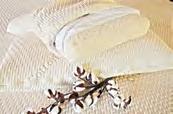


“All arguments being made against micromobility is that, ‘Well, we have the infrastructure for automobility. We’re going to carry on doing this.’ As everyone knows … you’re just pointing to the fact that it was done wrong.”
–Leslie Garrett
Come

IN A WORD 16 MARTHA’S VINEYARD /SUMMER 2022
Micromobility
|
in
\ mī-krō-mō-bi-lə-tē
a word
bed linens.
State Road, VH · 508-696-9600
purest
The Island’s source for organic mattresses, pillows, and
Ergovea is our organic and natural latex mattress brand, providing the purest night’s sleep; Ergovea’s pillows are paradise. Sleep and Beyond provides toppers, sheets, pillows, comforters and more of your bedding needs. 322
oceanbreezemvbedding.net Get the
night’s sleep
see our collection of organic sheets
COURTESY WIKIMEDIA COMMONS
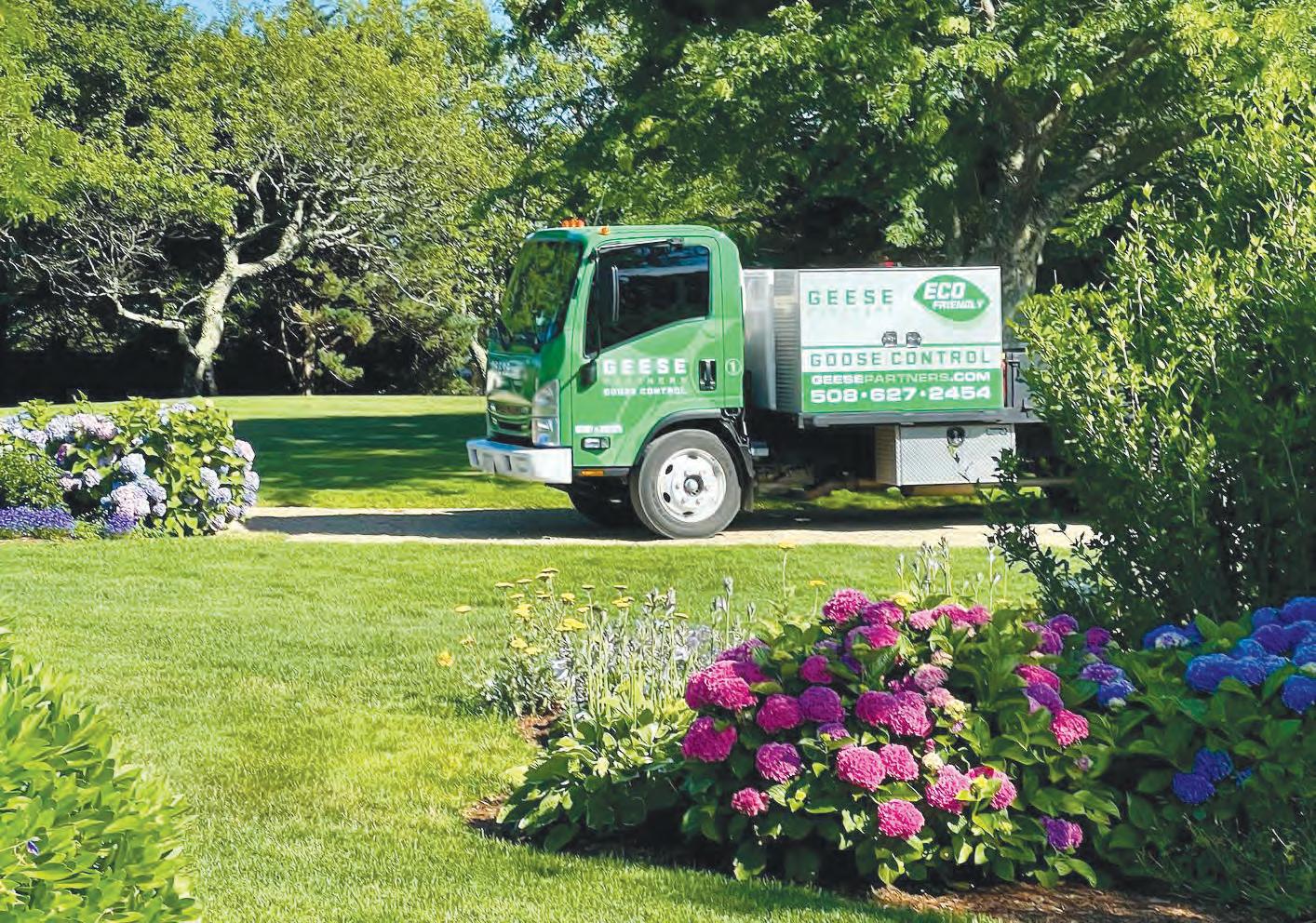

BDL 17 marthasvineyard. .com Take Back Your Turf Contact us today! (508) 627-2454 MV@GeesePartners.com GeesePartners.com Free Estimates Local & Year-Round Residential, Commercial & Event Goose Control Safe & Eco-Friendly Goose Control on Martha’s Vineyard Geese Partners of Martha’s Vineyard offers an eco-friendly, safe, and effective recurring goose repellent spray solution.
dot DEAR
program was a popular initiative, and its absence is keenly felt. Dot’s ears have been filled more than once with lament from those who miss it. Our friends at Earth911 tell us that recycling a ton of plastic bags (about 450,000) saves 11 barrels of oil. When bags are recycled, they are turned into pellets and typically used in products like Trex decking.
Even if Stop & Shop puts its bag collection back into place (and we hope it does!), keep in mind these words from Ben Robinson and the Plastic Free MV kids: “Any recycling is only temporary, eventually all plastic becomes waste at some point, and soft plastic recycling is hard to accomplish and hard to collect.”
Buried in Bags
Dear Dot,
We used to be able to take plastic bags to Stop & Shop [to recycle]. Is there any other option locally? Stop & Shop stopped taking them.
– Jana Bertkau
Dear Jana,
The eldest of my Young Dots recently spotted a bird on the ground. She moved closer to investigate and saw that the bird was on its back, its beak pointed skyward, and out of that beak was the edge of a plastic bag. This bird had choked on polyethylene, an all-toostriking symbol of how plastic has infiltrated every part of our planet.
Plastic bags are literally everywhere: in our waterways, in our trees, in our landfills, and in our many creatures. Plastic bags are among the most common marine debris. They are often mistaken for food and ingested.
Stop & Shop’s plastic bag recycling
Stop & Shop stopped collecting plastic bags when COVID hit, the manager at the Edgartown location told me. If you recall, there was much confusion and concern about transmission in those early COVID days, and most were playing it safe rather than sorry. The policy remains in place though the manager is currently investigating if and when it might be reinstated. (Update: An eagle-eyed reader told us that there are garbage cans in front of the recycling bins at the Edgartown dump where you can deposit your plastic bags for recycling.)
But one of the most important recycling rules is to do what we can to avoid single use plastics in the first place. This is the thinking behind Plastic Free July, a global initiative that challenges us to refuse single use plastics. Take reusable bags to the grocery store, avoid plastic packaging (yeah, I know. But we can try). And when you can, find a re-use for your plastic bags. Offer them up as poop bags to friends with pets. See if your local shop owner can make use of them. I used to donate to a church group who wove sleeping mats out of them.
Trashily, Dot
Composting Rules
Dear Dot,
Why can’t you compost cheese, yogurt, or meat?
–Nina Maruca, via email
Dear Nina,
I am meticulous about clearing my plate. Even so, the occasional meat scrap or piece of cheese evades my stomach. And I feel guilty about tossing those morsels in the trash to rot in a landfill.
While you technically can compost meat and dairy products, a lot can go wrong along the way. The Environmental Protection Agency places meat and dairy on its “What Not to Compost” list along with other items like pet waste, charcoal ash, and diseased plants.
But why? To start with, meat can attract rodents or pests to your compost bin. Raw
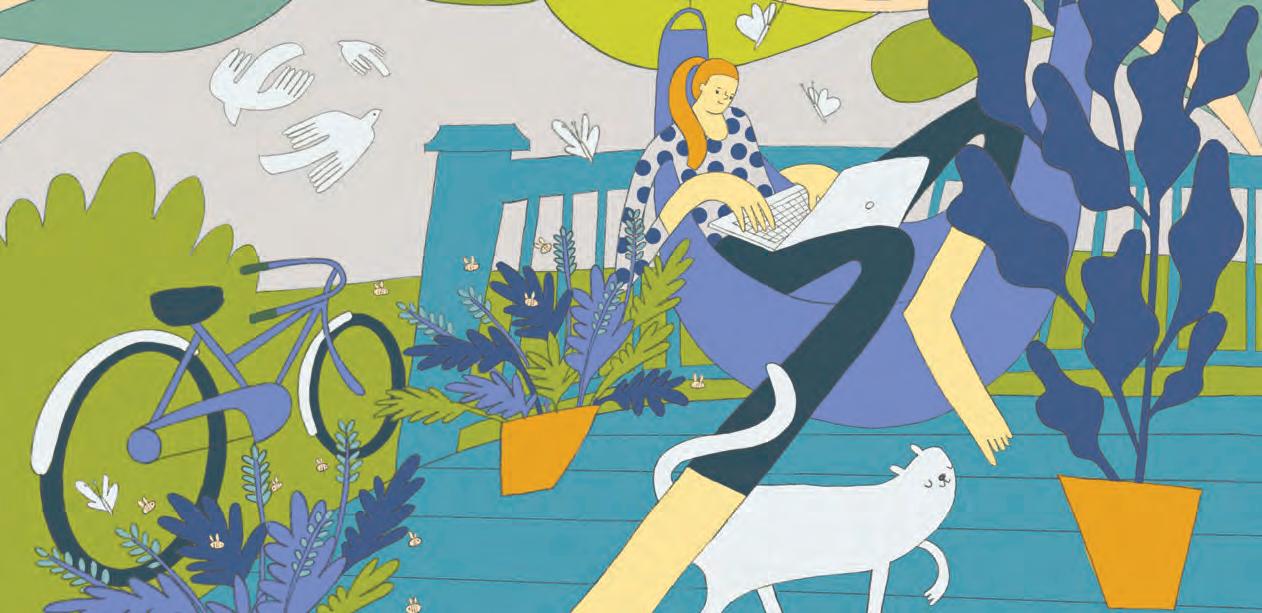
18 MARTHA’S VINEYARD /SUMMER 2022
Illustration Elissa Turnbull
meat also could be infected with E.coli or salmonella, which would allow bacteria to spread to crops that touch the compost.
The good news is that Martha’s Vineyard’s Island Grown Initiative (IGI) accepts meat and dairy scraps at its drop-off locations. Residents can find these sites at the Island Grown Farm, Chappy Ferry dock, and all town transfer stations. If you already patronize these services and have been throwing in your meat and dairy scraps with the rest of your compost there's no need to fret — it can all go in the same bin.
While there are a few options to compost such items at home, the process is a lot more difficult to get right, especially for the beginner composter. I chatted with Roxanne Kapitan from Garden Wisdom to get her two cents. “The whole goal of composting is to successfully be able to use what you compost in your home garden instead of buying bagged compost from far away using more plastic, more fuel, and all of that,” Kapitan said. Getting in over your head trying to compost meat scraps at home might ultimately be wasteful.
For the composting experts set on adding meat and dairy waste to their pile, the options include hot composting and anaerobic composting. Hot composting requires meticulous attention to keep the pile at 130 to 160 degrees Fahrenheit for a set amount of days. You’ll also have to turn the pile frequently. Anaerobic composting, which takes place in the absence of oxygen, can lead to pungent odors, and its final product is less nutrient-rich than that of aerobic composting. Anaerobic composting also generates much more methane than aerobic composting. In enclosed, largescale facilities this biogas can be captured and used as an energy source, but in the case of backyard composting the harmful greenhouse gas simply escapes into the atmosphere. Kapitan told me that even her devoted home composting friends sooner or later gave up on composting meat and dairy products — it was just too tricky to get it right and keep the
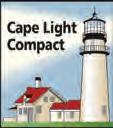

pests and stench away.
But now I’m stuck with moldy cheese that I just discovered in the back of my fridge wondering how I should responsibly dispose of it. The best solution to meat and dairy waste is to simply buy less of it in the first place (this will have numerous other positive environmental impacts too). Only buy as much as you’re going to eat so that you don’t waste it. Still, there will be times when you have some meat scraps left on your plate. Passing off your scraps to IGI recycling sites ensures that they will be composted correctly. Instead of trying your hand at composting these tricky items at home, Kapitan suggests keeping your scraps in the freezer and, once this collection gets too big, adding it to your compost bin and bringing it to a food waste drop-off site. Aerobically, Dot
Scan the QR code for more Dots!


DEAR DOT 19 marthasvineyard. .com
Keep your home or business cool with a heat pump Rebates available! 1-800-797-6699 CapeLightCompact.org Efficient cooling in the summer and heating in the winter, all in one system heat pump Rebates available! 1-800-797-6699 CapeLightCompact.org Efficient cooling in the summer and heating in the winter, all in one system SIGN UP FOR THE HUB OUR NEW BLUEDOT LIVING NEWSLETTER Featuring Simple Smart Stories from All Over - Advice for everyday livingBuy better marketplace - Recipes And a universe of great ideas *Sign up at bluedotliving.com/newsletter and be entered to win a $200 Atria gift certificate.
FIELDNote

From: BiodiversityWorks
Subject: MV Atlas of Life and the BioBlitz
Now in the middle of its second full year, the Martha’s Vineyard Atlas of Life (MVAL), a joint project of BiodiversityWorks and the Betsy and Jesse Fink Family Foundation (BJFFF), is steadily expanding the resources and activities it offers to Island naturalists.
“The MVAL,” says program director Matt Pelikan, “was launched with two main goals in mind: to provide a living catalog of the unique biodiversity of Martha’s Vineyard, and to encourage an active human community working to study, appreciate, and conserve that diversity.”
Both the scientific and the social goals of the program are advanced by events such as a “BioBlitz” hosted June 17-18 at Long Point Wildlife Refuge, one of the Vineyard’s finest conservation properties. Teaming with The Trustees of Reservations, which owns and manages Long Point, the MVAL enlisted 14 nature enthusiasts for a 24-hour, intensive survey of the refuge’s wildlife.
MVAL and BiodiversityWorks staff carried out a range of overnight, nonlethal sampling for nocturnal wildlife, setting up live traps for small mammals, minnows, and turtles, along with an acoustic bat detector, a game camera to look for otters, and a moth sheet (a white cloth illuminated by ultraviolet light to attract nocturnal insects).
Then, during the daylight hours of the BioBlitz, small teams of naturalists fanned out into Long Point’s varied habitats to search for and photograph plants and animals, uploading their discoveries into the community science web platform iNaturalist.org. Trustees and BiodiversityWorks staff also ran a family event on the shore of Long Cove Pond, using an array of nets to
sample for aquatic life and sharing the results with enthusiastic children.
When the dust had settled, the BioBlitz had documented a remarkable total of 314 species. Included in the list were a number of rare or uncommon species, such as an orange bluet damselfly (Enallagma signatum). The species entered into iNaturalist can be viewed at bit.ly/I-nat-BIOBLITZ. Forty-seven species of birds were recorded separately using eBird.org, another community science platform.
As impressive as the event’s results were, participants agreed that the social angle of the event was as enjoyable as the search for wildlife.
Beginners had an opportunity to learn from some of the Island’s best naturalists, and everyone had the chance to share their love for the rich biodiversity of the Vineyard. Another BioBlitz was in the works as this article went press, set for July 15-16 at Hoft Farm Preserve and run in cooperation with The Nature Conservancy.
More BioBlitzes figure in MVAL plans for the future, joining other educational and social events such as webinars and in-person walks and training. The MVAL is also working with the BJFFF and eight Island farms on a project to study and enhance the diversity of Island agricultural land. The MVAL project on iNaturalist collects observations uploaded into the platform from Martha’s Vineyard; the project currently holds about 16,000 individual observations representing more than 2,800 species.
The point of documenting biodiversity is ultimately to make that information available to anybody with an interest in local flora and fauna. Toward that end, the MVAL recently launched a website at mval.biodiversityworksmv. org. The site includes links to important community science platforms, an archive of MVAL webinars on natural history, a look at significant recent sightings, and a collection, expected to grow over time, of Vineyard checklists for various groups of animals. The site will link to a stateof-the art catalog of Vineyard plants maintained by Polly Hill Arboretum.
The checklist section has its roots in an earlier generation of technology: Island Life, a hard-copy book authored by Chilmark naturalist Allan Keith and the late Stephen Spongberg and published by Keith in 2008. Over the last few years, with Keith's cooperation, the checklists and essays on Island Life have been digitized by BiodiversityWorks and the MVAL, with new species added and biological taxonomy and nomenclature updated. Several sections, notably bees and Orthoptera (grasshoppers, crickets, and katydids), have already been added based on research conducted since Island Life was published.

MVAL director
Pelikan anticipates adding sections on flies (Diptera) and true bugs (Hemiptera) by year’s end, drawing on data compiled in the MVAL iNaturalist project.
“These are golden times for naturalists,” Pelikan says. “Advances in optics and digital photography, the advent of DNA analysis as a tool for classifying wildlife, and the flow of information and personal communication made possible by the internet have revolutionized how nature is studied and how naturalists interact.” The MVAL and its new website represent an ambitious effort to harness that progress to document and conserve the unique natural heritage of Martha’s Vineyard.
FIELD NOTE 20 MARTHA’S VINEYARD /SUMMER 2022
To : Bluedot Living
LOCAL HEROES
The Bluedot community salutes

Pam Goff and Tess Bramhall for their many years of caring for our Island.
Gratefully, Vicki Riskin and David W. Rintels, Rose Styron, Davis and Elizabeth Weinstock, Penny and Phil Weinstein, Wendy and Bill Luers, Connie Ellis, Charlayne Hunter-Gault and Ron Gault, Sarah Catchpole, Rick Grand-Jean, & Christine Doudna.

BDL 21 marthasvineyard. .com
Cruising with Currier
FEATURING KRISTI AND ALAN STRAHLER LEADING THE CLIMATE WEEK CONVOY.
Bluedot Living loved Climate Week back in May. Because our spring issue was already in production that week, we couldn’t report on Climate week for the magazine. But our intrepid columnist Geoff Currier was on the ground. Or rather, in the backseat of a Nissan Leaf, in the convoy of electric cars that cruised to the Grange on Climate Week’s final day.
Not that long ago, you probably couldn’t find 30 electric vehicles on the entire Island. But on May 14, 2022, more than that number of EVs and hybrids got together to form a procession that traveled from the Edgartown School to the Grange Hall in West Tisbury to draw attention to the climate crisis and our ever-evolving solutions to it. I had the privilege of
riding in the lead car with Kristi and Alan Strahler — it was Kristi who originally conceived of the idea for the event.
We drove in the Strahler’s 2015 Nissan Leaf. Alan sat in the passenger seat, calling ahead to apprise the police of our progress. Kristi drove, and I sat in the back seat like a duffle bag, peppering Alan and Kristi with questions.
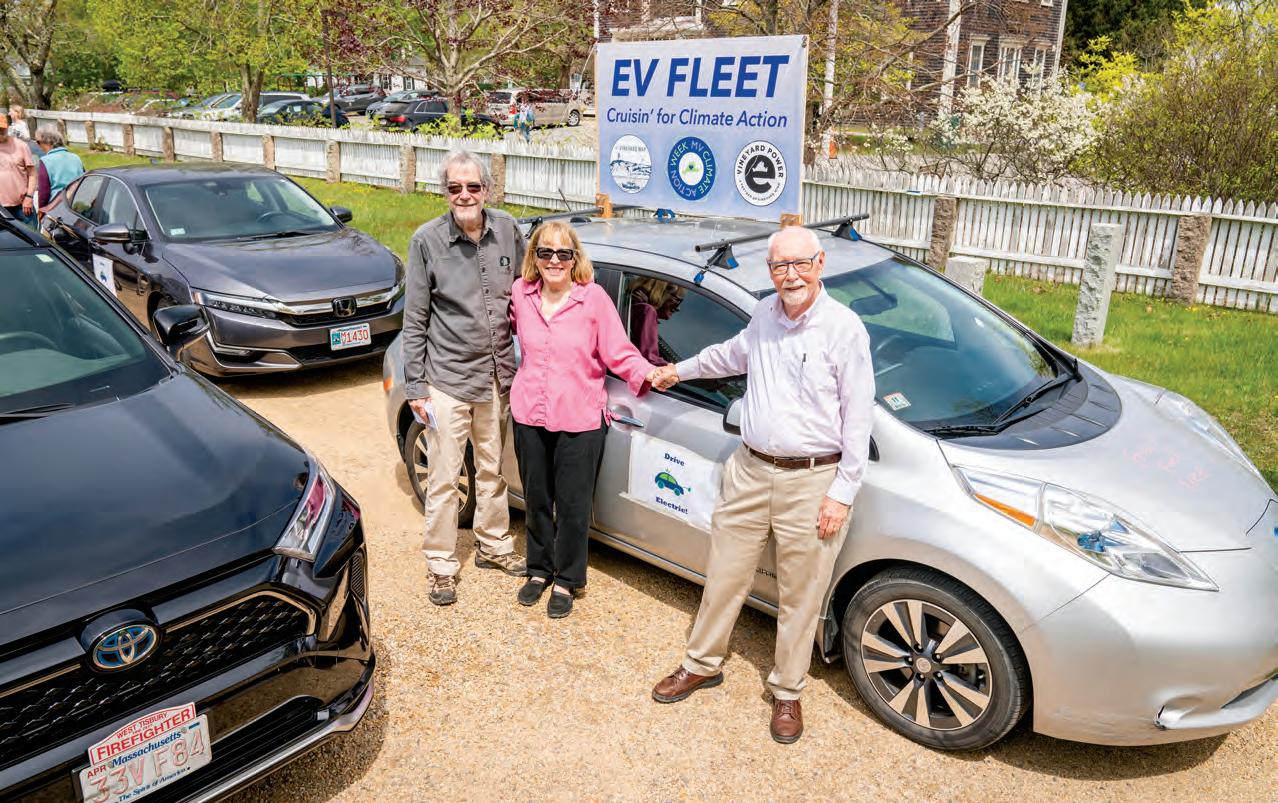
Both Kristi and Alan are retirees who transitioned from being seasonal Island residents (since 1989) to fulltimers in 2016. Kristi is a former nurse, specializing in operating room care, and Alan is a former professor from Boston University’s Earth and Environment Department.
Alan explained to me that in 2018 the Martha’s Vineyard Commission (MVC) hatched a committee called the Climate Action Task Force to look at what could be done on an Island-wide basis to deal with climate change. And they were able to get a grant from the state to fund the
development of the Climate Action Plan, now called The Vineyard Way. Reps from Island climate and energy committees, as well as many other Island organizations and the staff of the MVC, participated in developing the plan.
“Climate Action Week has been in planning since March of 2021,” Kristi said. “It was originally planned to coincide with the Glasgow Climate Summit, which was held in November, but unfortunately Covid hit, so the celebration had to be rescheduled to the week of May 8.”
Kristi, who participated in 2021 in the education subcommittee of the Task Force, realized something dramatic had to be done to underscore the mission of the Climate Action Plan. She imagined an EV parade culminating at the planned Climate Week finale event at the Grange Hall. Kristi presented her idea to Liz Durkee, MVC climate planner, and Liz thought it was a great idea.
22 MARTHA’S VINEYARD /SUMMER 2022
Kristi got Erik Peckar, general
CRUISING WITH CURRIER
Story by Geoff Currier Photos by Jeremy Driesen
manager of Vineyard Power, on board, along with Richard Andre, president of Vineyard Power, and they agreed to sponsor the event.
While the idea of a parade received broad approval, there was some discussion about what the parade should be called. As one person pointed out, to call it a parade seemed to imply that there would be onlookers, but practically speaking it’s not like there would be many people lining the streets on the back roads of the Vineyard in May. So Kristi suggested that the term “parade” be changed to “convoy.” Jed Katch, who was driving his Nissan Leaf (see Currier cruising with Katch here: bit.ly/Cruising-Katch) in the “convoy,” remarked to me later that one of the things he liked was how some people lined up by the side of the road in Chilmark to cheer on the EVs.
“Since January,” Kristi said, “there have been programs being staged on all aspects of responding to climate change.” The list of activities and events only intensified over Climate Week to include presentations on oyster farming, native flowers, composting and regenerative gardening, and energy-efficient homes.
As the convoy approached the Grange Hall, it was evident that the news of the fair had spread, and the parking lot was rapidly filling up. Kristi drove around the

Grange Hall to park to the right side of the building with 35 cars behind.
Kristi said that the convoy had two mandates: to draw attention to the fossil-fuel climate crisis and to underscore electric cars as a solution to the problem. The other reason was to have fun. And stepping out of the car, it was immediately evident that this was the fun place on the Island to be. A bluegrass band played fiddles on the front porch, there was plenty of great food, and people were milling about the grounds enjoying each other’s company, exchanging information about EVs, and taking a close look at the cars in the convoy, which included a few Chevy Bolts, Tesla Models 3 and 4, a BMW 318i, and several Nissan Leafs, among others.
Adjacent to the parked EVs, Vineyard Power’s Richard Andre and Luke
Lefebvre manned a table where they explained the economics of buying and driving electric vehicles.
Inside the Grange Hall, there was a boatload of tables set up to dispense information on climate change. Kids roamed around, eying the status of artwork and essay competitions.
Upstairs at the Grange Hall, the room was set up for speakers, including a presentation on the MVC Climate Action Plan and speakers from the MVRHS Environment Club. There was also a film presented by the MV Film Festival.
On balance, everyone I talked to seemed to agree that the day had been a big success, and at a time when the waters are getting hotter and the storms are getting stronger, it was a good day to take an EV ride in the right direction.
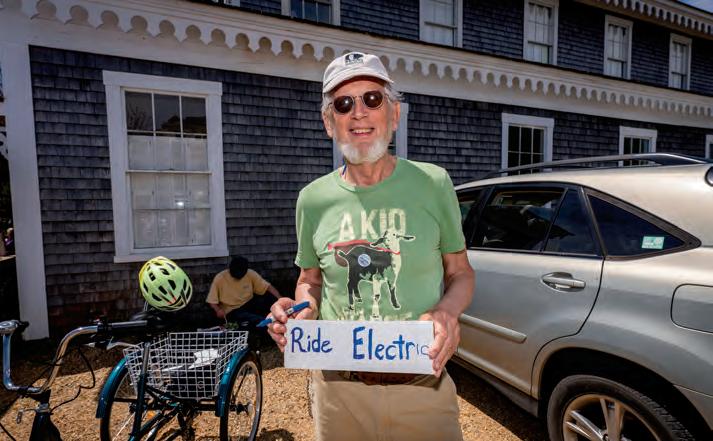
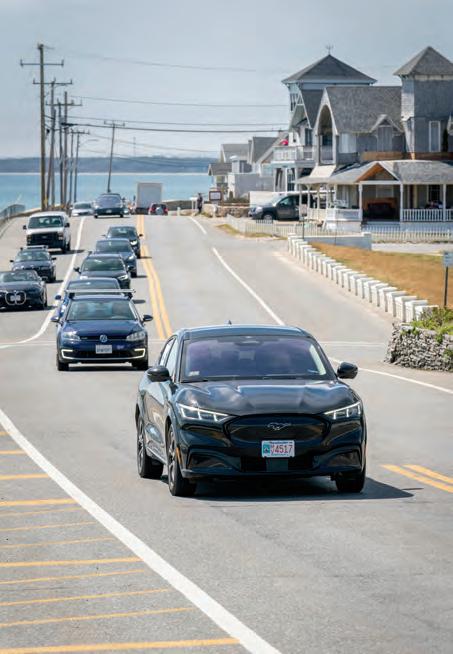

CRUISING WITH CURRIER 23 marthasvineyard. .com
Sidney Morris
Rebecca Gilbert:
Foraging Farmer
And the author of the new book, Weed Wisdom
By Catherine Walthers Photos Sheny Leon
Rebecca Gilbert remembers living through Hurricane Bob in 1991 and says it was a wakeup call for her. In the aftermath of what was declared a national emergency in the state, water flooded Island streets and our major roads were blocked by a tangle of branches, poles, and 2,400 downed power lines. Electricity was out in some places for seven to ten days. Power at Cronig’s supermarket was out for six days. Gilbert wonders about living in a future with climate changes where potentially much worse is predicted for us.
“I get scared and nervous and worried, then I look around for what we can do,” says the 67-year-old owner of Native Earth Teaching Farm in Chilmark.

To Gilbert, those answers are right around us — plants, common wild
plants in our backyards she often refers to as weeds. In times of need, those plants can offer first aid, food, and inspiration. It’s the subject of her new book out this month — Weedy Wisdom for the Curious Forager: Common Plants to Nourish Your Body + Soul — and of an eye-opening talk she gave during Climate Week this past spring.
If medical help is delayed or scarce, knowing about plantain or yarrow, for example, could be “very helpful, even lifesaving,” says Gilbert. Both plants have a reputation for stopping bleeding and preventing infections from taking hold. “You don’t have to be an herbalist to know these things. If you just know those two plants, you have the first line of defense.”
Gilbert learned about plantain as “the Band-Aid plant,” as her
grandmother called it, during the first summer she stayed on the Island with her grandparents at age six. Her grandparents, homesteaders, were raising a few farm animals and growing their own food on 30 acres they had purchased on North Road during the Depression. That year, with her grandmother’s encouragement, she also learned to identify sassafras, wintergreen, and mint. Gilbert spent the next 60 years watching and studying the plants — cultivated and wild — at the farm.
“I’m a big believer in getting to know a plant for a while before you really start using it in a lot of ways,” she says. “If you follow it through a life cycle and watch it go through its changes, you’re going to know it well enough to feel comfortable using it.”
You should also look around at your
24 MARTHA’S VINEYARD /SUMMER 2022
neighbors, Gilbert suggests. Who has a generator, who may have a stocked pantry, who has saved seeds? Who can help us in times of disasters and who might need our help, such as seniors or those who are homebound? Knowing these things ahead of time, including gaining an understanding of plants, could help us.

Just as importantly in these times ahead, she believes, weeds can offer inspiration and guidance.
“A weed is a plant with a good survival strategy,” she says. “They are there for us when we need them.”
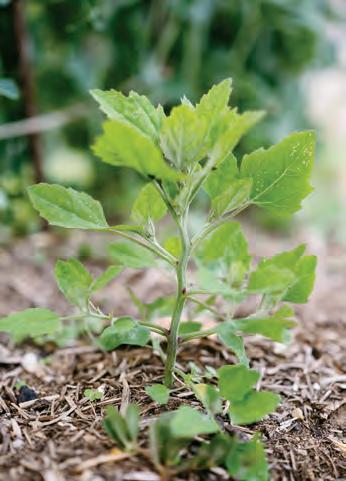
“Plants are way older than us. Plants have already oxygenated the world to get ready for us.” In other words, says Gilbert, “plants have adapted already. They know how to do that better than us.”
Humans often tend to act as if we are separate from nature, she points out, but “we are nature” not man versus nature, a stance that has led to “pollution, exploitation, and the disruptions of the natural systems of balance.” Like us, says Gilbert, weeds are interwoven with their ecosystem and cannot survive alone.
“I’ve observed them evolving and adapting. Diversity is how you move
forward when things change. We are much safer to have as much diversity as possible. Who knows what we’ll need, what we’ll have to adapt to next.”
Gilbert’s message has been echoed by others who say our monoculture-based food system — with only a handful of varieties of say bananas, avocados, coffee, and other foods — leaves the system vulnerable to climate breakdown when a single pathogen or drought can wipe out an entire crop. Mass producing just a few varieties, wiping out thousands of years of diversity, has significantly interfered with crop resistance, scientists and climate experts say. Cultivating and eating a variety of genetically diverse food will protect us from future pests and diseases.
The need for adaptation is a little like the arc of Gilbert’s life. At one point, Rebecca, one of three siblings, overheard her family contemplating selling the farm on Martha’s Vineyard since no-one was living there. Her father, an only child with a childhood of farm chores, had long ago traded Island farm life for city life to work in computer-based medical research. Rebecca decided she would come here to live and save the farm. She was in her twenties, a graduate of Washington State College with interests in boat building, silversmithing, and writing, but also struggling with depression and thoughts of suicide.
“I was a mess when I came here,” she says. “I did not have a lot of self-respect.” She said she wasn’t exactly sure why she was even at the farm.
Eating fresh food from the farm, managing the chores and animals, and being outside, and getting daily exercise all helped and healed her, she says. “The farm, basically in various ways, is what really made a difference for me. I didn’t realize how many bad habits I was in. I kind of like mentioning the dark times because I am so happy and confident now.”
The Wisdom of Weeds
Often, the very plants you may need have a way of showing up around you, Gilbert writes about in Weedy Wisdom. “Turn to your elders, the weeds, when you need help and healing. Ask them directly for their assistance. The depth of their wisdom and generosity never fails to amaze me.”
FEATURE • FORAGING FARMER 25 marthasvineyard. .com
“A weed is a plant with a good survival strategy, they are there for us when we need them.”
-Rebecca Gilbert
From left: lamb's quarter sprouts in the garden; A basket of wildflowers — violets, chamomile, red clover.
When Gilbert got Lyme disease some years back and was bedridden, she had no energy to prepare meals or keep up her garden, which was filled with weeds. So she ate the weeds. “They were there, so dense with flavor and nutrition. They nourished me deeply.”


She continued to strengthen her relationship with plants, and officially
opened Native Earth Teaching Farm to the public in 2002. Along with tours for school children to see farm animals and farm life, Native Earth offers community gardening, classes in fiber arts and natural dyes, goat yoga, and is home to a new cultural center in partnership with Island musician and drummer Rick Bausman. Now that the book is out, Gilbert has
Rebecca says a weed is "a plant with a good survival strategy," including the amaranth (bottom), also known as red root pigweed.
been lecturing around the Island about the power of plants, and offering weed walks and classes at the farm.
Her new book, written during Covid, is based on a series of classes at the farm with Camp Jabberwocky. Campers with disabilities spent eight weeks learning to recognize plants, learning about edible flowers, using roots and seeds, working with fermentation, cooking techniques, and healing first aid plants. These lessons are now chapters in the book.
“The focus is on how to appreciate
26 MARTHA’S VINEYARD /SUMMER 2022
Humans often tend to act as if we are separate from nature, Rebecca Gilbert points out, but we are nature .
Note: These Mediterranean stuffed grape leaves taste delicious dipped in a yogurt sauce. Drain Mermaid Farm yogurt slightly in a coffee filter to thicken. Mix in a little garlic, cumin, lemon juice, and salt. Drizzle with olive oil.

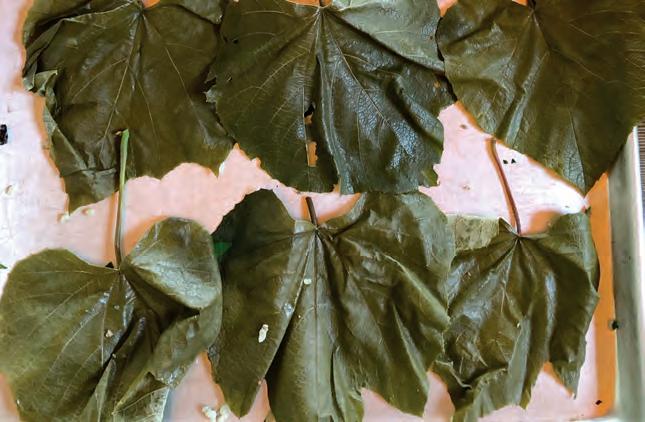
MEDITERRANEAN STUFFED GRAPE LEAVES
Pick tender young leaves, growing at the end of grapevines. Leave the stems on. Wash, if necessary. To blanch, use the stems as “handles,” or use tongs to dip three to six leaves at a time into boiling water, swish once, remove, and drain. They should soften and turn olive green, but not cook. Continue until you have blanched all the leaves. Trim off the stems with scissors. The grape leaves are now ready to stuff. Or, roll the blanched, stemless leaves into loose cigars, pack a jar, cover with brine, label, and store in the fridge for up to a year. Or, roll into bundles, wrap tightly, label, and freeze.
3 dozen grape leaves, blanched
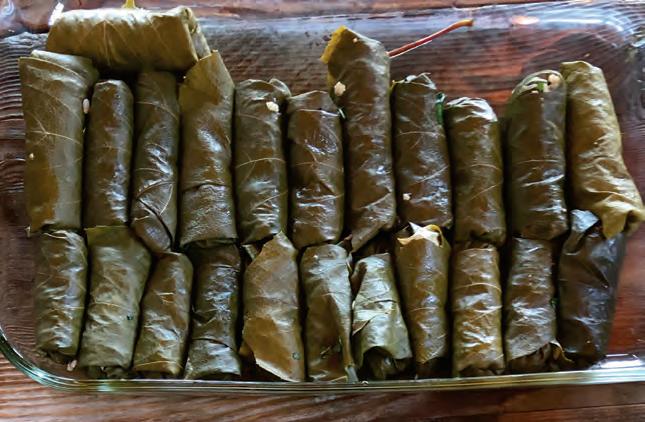
4 cups of any favorite rice, cooked, warm or cold (if the rice seems very dry, add ¼ to ½ cups of water)
1 cup or more of finely chopped herbs, such as plantain, sorrel, lamb’s quarters, and pigweed (or parsley, dill, and mint) ½ cup olive oil
Other traditional additions
Onion or shallot, chopped and sautéed Lamb or venison, ground and cooked L emon peel, grated
Preheat the oven to 350. Mix the rice with herbs and any of the other traditional additions.
To stuff, place a blanched leaf face down on a flat surface, and put a small amount of filling above where the stem was. Fold up the bottom two lobes, fold in the sides and roll toward the tip of the leaf to form a finger-shaped cylinder. Generously oil a glass baking dish with olive oil (lasagna-sized approx.) and nestle your rolls tightly side by side in a single layer. Drizzle the remaining olive oil over the top, cover with foil, and bake in the oven (or over low coals until sizzling through and through) for about 45 minutes. They are delicious hot, or chilled on a summer afternoon, but traditionally served at room temperature. Serve with a yogurt tzatziki sauce.
FEATURE • FORAGING FARMER 27 marthasvineyard. .com
PURSLANE QUICK PICKLES
Whole purslane has thick, crunchy red stems and small, succulent, green oval leaves and may be quick pickled for an interesting textural contrast. Purslane is an extremely nutritious plant with more vitamin C, vitamin E, and omega 3s than most other greens, and a range of minerals including iron and calcium. It has a delicious mild lemony flavor. It also provides a good base for experimenting with wild herbs and spices. Try a sprig of yarrow or a twig of juniper, Rebecca suggests.
Ingredients:
Purslane, water and vinegar for brine
Mix up a brine by combining vinegar and water, half and half. Any kind of vinegar may be used; each will add its unique flavor. Add any herbs and spices you like, somewhat sparingly, as the flavors tend to become stronger in the pickle. Salt is optional, as is some form of sweetener. Pack the purslane loosely into a jar and cover with the brine. Leave at room temperature and use that day, or refrigerate overnight or longer, up to several weeks.
REBECCA’S LEFTOVER GREENS

Some wild greens or weeds Rebecca suggests for this include lamb’s quarters, amaranth, and wild mustard greens. “This dish is so good,” Rebecca says, it’s worth making leftovers on purpose. I never measure when I make this, estimating according to the quantity of greens I have left over. You can do the same, using this recipe as a guide.”
1 cup cooked, very well-drained greens
1 teaspoon soy sauce or tamari
1 teaspoon vinegar,preferable rice or balsamic
½ teaspoon toasted sesame oil
1 splash hot sauce, or to taste
Toss to blend and refrigerate overnight. Eat the next day, ice-cold.
them, how to approach learning from and about plants, and how to deepen the connections that already exist,” says Gilbert. “The learning part can be fun.”
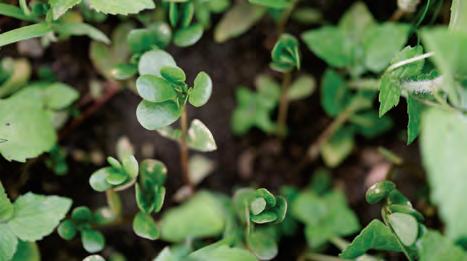
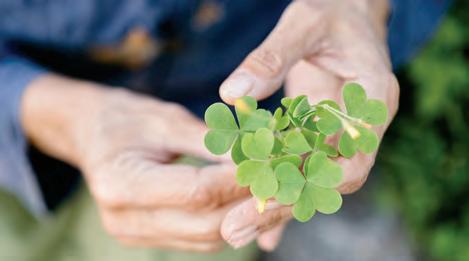
Gilbert herself often picks a basket of wild greens, such as chickweed and mustard, much like Europeans and many Indigenous peoples did for hundreds of years. “Sometimes I pick the vegetables and sometimes I pick the weeds,” she says. “Medieval salads included more than a hundred herbs, flowers, and vegetable leaves, as well as greens like lettuce and mustard still in use today.” Some of the weeds and invasives (see “What’s So Bad About Invasives”) she writes about found their way to the colonies with European settlers, some with seeds in hay, others brought as medicine, Rebecca discovered in her research.
The day I visited, Rebecca had picked a pile of lamb’s quarters, a mild leafy wild green in the spinach family. She planned to cook lamb’s quarters down and combine them with potatoes for dinner. As we walked around the farm, we walked by a high-bush blueberry grove more than 100 years old, another fenced area with 12 pawpaw trees and her mother’s orange mint patch. Weeds grow here and there, especially in and around various vegetable gardens. But not all weeds are allowed to take over, she notes. “Just because it’s a weed we eat doesn’t mean it gets free reign.”
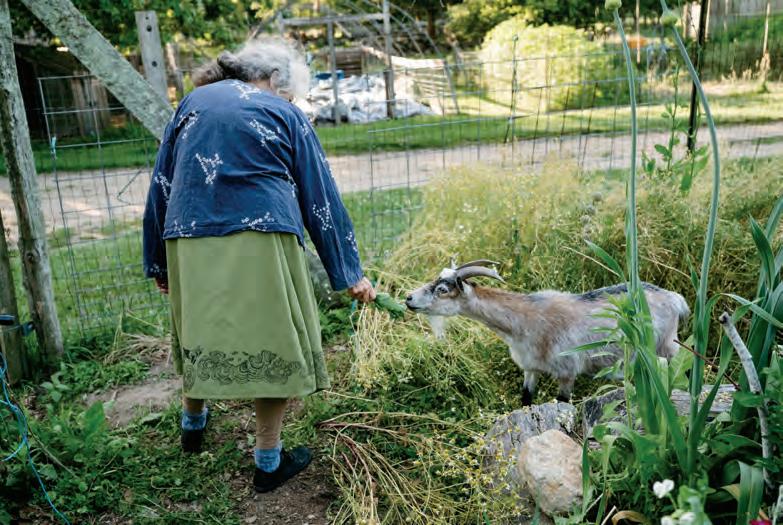
FORAGING FARMER • FEATURE 28 MARTHA’S VINEYARD /SUMMER 2022
Sorrel looks a bit like lucky clover.




BDL 29 marthasvineyard. .com Native plant specialists and environmentally focused organic garden practices. Design • Installation • Maintenance (508) 645-9306 www.vineyardgardenangels.com Garden Angels Bring beauty to your property Thank you to everyone who participated in Climate Action Week this spring! The MV Climate Action Plan, The Vineyard Way, can now be viewed at www.thevineyardway.org. The Vineyard Way is a 20-year, community-based plan for Vineyard climate change resilience. It includes over150 actions that will be implemented to address the cause – fossil fuel use –and the impacts of climate change, as well as suggestions of things every one of us can do to make a positive difference. A special thank you to the 100+ community members on the Climate Action Plan team.
The Vineyard Way was made possible through a grant to the Martha’s Vineyard Commission from the MA Municipal Vulnerability Preparedness Program.
Cindy Kane
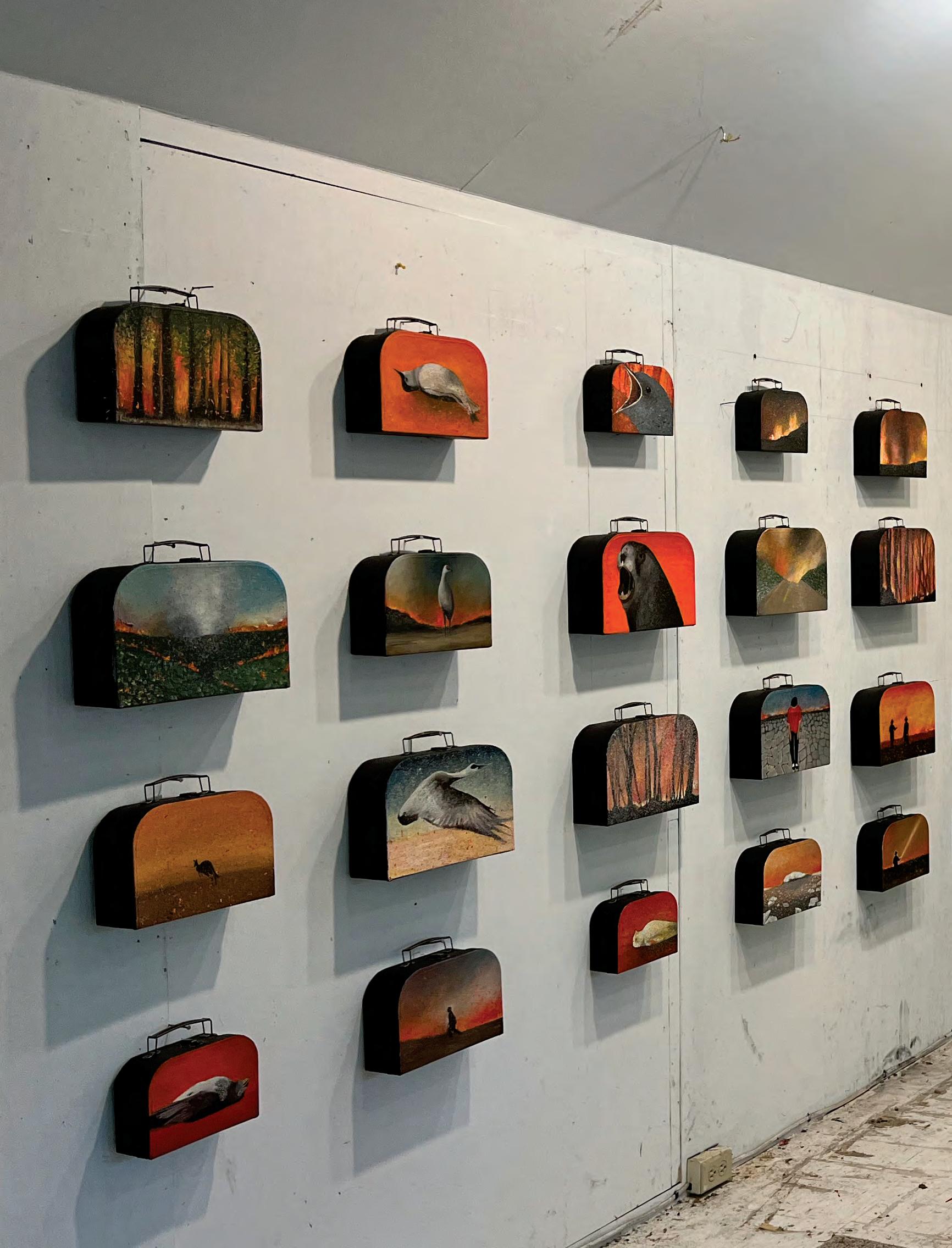
THE BAGGAGE OF CLIMATE CHANGE • FEATURE 30 MARTHA’S VINEYARD /SUMMER 2022
Unpacks The Baggage of Climate Change

31 marthasvineyard .com
FEATURE • THE BAGGAGE OF CLIMATE CHANGE
Story by Kelsey Perrett Photos Courtesy of Cindy Kane
What does ecological grief look like? What does it mean to carry our psychological encumbrances through the world?
As the impacts of climate change become more apparent on Martha’s Vineyard and around the world, artist Cindy Kane has stayed grounded by tending her backyard garden, walking with friends, and immersing herself in literature. Of all the books Kane has read in recent years, one title especially moved her: The Things They Carried, Tim O’Brien’s semi-autobiographical collection of Vietnam war stories. Not just the book, but the title itself. It percolated in her mind, bubbling to the surface again and again until finally, it triggered Kane’s latest body of work — a collection of painted suitcases called “Destination Unknown: Claiming the baggage of climate change.”
Kane credits her friend Polly Clive for the name of the work, but she credits O’Brien for catalyzing her exploration of baggage and what it means to carry our collective psychological encumbrances through the world. “I started thinking, what does ecological grief look like? What does it feel like?” Kane said. “As humans in this period of time, we carry so much. I
The first suitcase Kane painted was sourced from a thrift shop. With a layer of gesso and a blaze of acrylic paints, its leather exterior transformed into a landscape of scorched earth, a horizon fringed with fire.
think we carry a lot of shame about what we’re witnessing, the extinction of species that we love, the devastation of habitats that we love, and it’s playing out before our eyes … Suitcases, to me, are the quintessential representation of what we carry.”

32 MARTHA’S VINEYARD /SUMMER 2022
The first suitcase Kane painted was sourced from a thrift shop. With a layer of gesso and a blaze of acrylic paints, its leather exterior transformed into a landscape of scorched earth, a horizon fringed with fire. That piece, Traveler 2020, will be part of Kane’s show at the Granary Gallery, which opened on July 31. Upon its completion, Kane envisioned even more suitcases, a grid of them arranged on a gallery wall, each individual painting a voice in a chorus that forewarns an uncertain — but nonetheless fraught — environmental future.
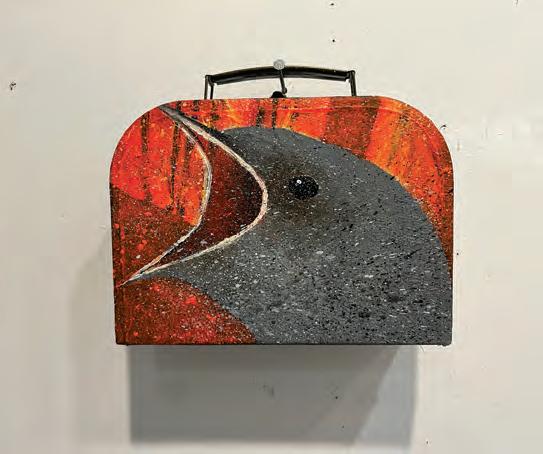
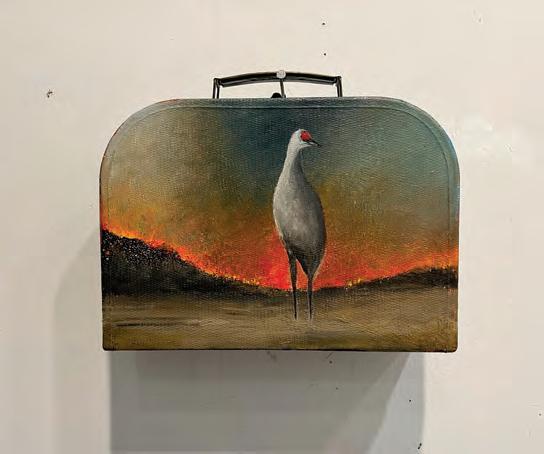
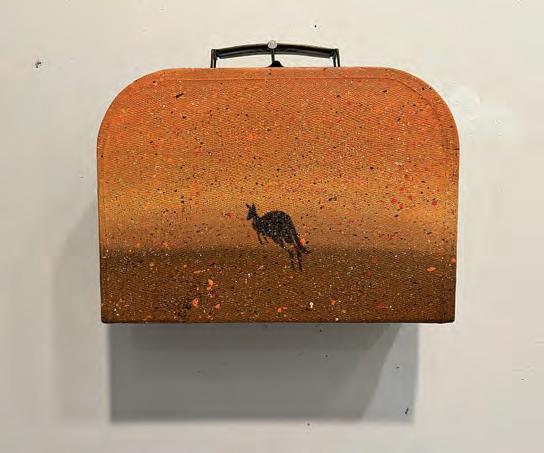
The suitcases depict landscapes overwrought with flames. Wildlife — birds and seals and kangaroos — howl against a sky of ash and ember, or else lie belly-up and still. Humans hold steadfast streams of water against the inferno, and where they cannot, they hang their heads and turn their backs to the heat. “I’m really trying to emulate what I see on the news, the photos on the front page of the newspapers,” Kane said. “I’m using symbols of what I see reflected in the news as one of the many faces of the installation. So we’re kind of looking at ourselves.”
In this mirror Kane has created, the viewer has a chance to process the guilt and the grief of climate change through the experience of looking. But as the title of the piece reminds us, a mirror is not necessarily a crystal ball.
“It’s an unknown destiny,” Kane said. “We basically know where we’re headed. But we don’t know what’s going to happen.” In other words, there is still room, in that liminal space, for hope.
Given Kane’s professional history, it’s unsurprising that she gravitated toward O’Brien’s wartime opus. Her installation, The Helmet Project, integrated handwritten notes from war correspondents onto painted steel combat helmets. Kane’s commentary on our relationship with the natural world is also well documented. Her exhibit, Empty Skies, at the former marine hospital paid a funereal homage to 24 extinct birds. “I see all these as a continuum,” Kane said.
That’s all Kane hopes the piece does: continue the conversation, evoke “an ongoing internal dialogue” after viewers leave the exhibit. “I want them to think about it later, the way I think about that title, The Things They Carried,” Kane said. “I guess I could say that I would like the piece to be someone's Tim O'Brien.”
FEATURE • THE BAGGAGE OF CLIMATE CHANGE 33 marthasvineyard. .com
We basically know where we're headed. But we don't know what's going to happen. In other words, there is still room, in that liminal space, for hope.
What’s So Bad About
By Leslie Garrett
Pavement?
It’s easy to overlook that stuff beneath our feet and our vehicles. But reimagining our paved spaces can go a long way toward not only reducing urban heat but also creating community and restoring justice.
In 1894, according to Vineyard historian Chris Baer in his book Martha’s Vineyard Tales, the New York Times published a story celebrating the Island’s concrete roads, at least 40 miles of them around Cottage City. These roads, the paper of record declared, offered a cyclists’ paradise, the best in the country outside of Washington, D.C. These days, few would cite pavement as a signature feature of Martha’s Vineyard. And most of us like it that way, proud of the dirt
roads that zig and zag the Island. But those dirt roads carry benefits beyond slowing down drivers and preserving a rural vibe. Pavement holds heat, creating what’s called the Urban Heat Island effect (UHI), which is not just uncomfortable for residents but potentially deadly. As a result, urban planners are looking for ways to mitigate this effect. And a movement that aims to “depave” parts of towns and cities is taking things even further — to remove an unhealthy built environment and

replace it with green space that combats the UHI effect and also contributes to the social health of a community.
Phoenix, Arizona
While you might not know that a pavement temperature of at least 158°F is required to fry an egg, the folks in Oatman, Arizona do. Each July 4, the town hosts its annual solar egg frying contest, so “hot enough to fry an egg on the sidewalk” isn’t just hyperbole for them. But just 200 miles southeast of Oatman
34 MARTHA’S VINEYARD /SUMMER 2022 WHAT'S SO BAD ABOUT PAVEMENT? • FEATURE
"Eastville," oil on linen, by Jeanne Staples. See her show at the Granary Gallery until August 13.
is Phoenix, where a new pilot project is actively working to make egg frying on asphalt difficult if not impossible — by creating what’s called, appropriately enough, “cool pavement”.
In Phoenix, which has more than 300 days of sunshine and temperatures that routinely top 110°F, street surface temperatures reach up to 180°F, says Spencer Blake, a public information officer for the city. That’s not only unpleasant and unhealthy, it can be deadly.
This UHI effect disproportionately affects lower socioeconomic communities and marginalized people, and Phoenix is taking an innovative approach to tackle it.
The city began its pilot project in 2020 to apply a reflective coating to asphalt to eight neighborhood streets and one park, all due to undergo routine maintenance. The waterbased treatment is a mixture of asphalt, water, mineral fillers, polymers, and recycled material. There are no harmful chemicals that will run off the surface onto green space or waterways, says Heather Murphy, who works in Communications and Public Engagement for the City of Phoenix Street Transportation Department.
“We’re using a product that’s 100% compatible with the asphalt so that when it reaches the end of its useful life, we can mill it, filter it, grind it into new asphalt, and repave with it,” she says. Consequently, not only can the city combat the Urban Heat Island effect, Murphy says, “we’re buying less raw material.”
The pilot project has expanded to add another eight new neighborhood streets that were scheduled for maintenance. The “cool pavement” isn’t designed for the high-traffic areas of main city streets or freeways. But, says Murphy, “where do people walk their dogs, stroll with their children, or play a pickup game of basketball?
They do that in their neighborhoods.”
According to Spencer Blake, results from the pilot showed a successful reduction in street surface temperatures of between 10°F and 15°F. The coating is more expensive than what the city typically used but, says Blake, indications are that it is more effective and longer lasting.
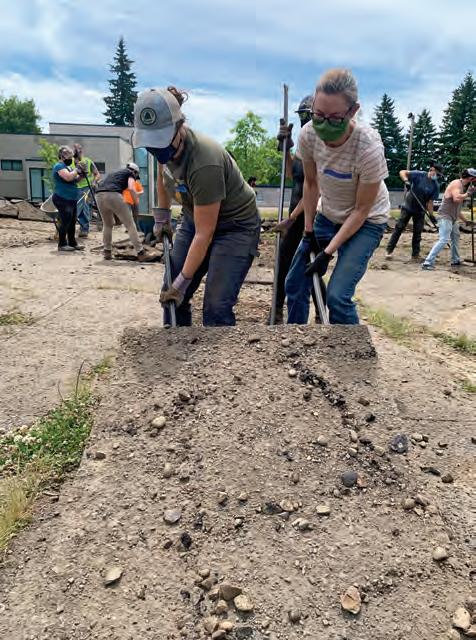
in recreating their spaces.
The two make up the staff of Depave, a sort of ground zero for the deconstruction movement. Depave began in Portland, Oregon, in 2008 with a simple conclusion: Pavement is the problem. The solution, therefore, was to depave, to remove pavement where possible and replace it with nature.
“We were kind of the first organization to coin the term ‘depaving’ back in 2008,” says Katherine Rose, Communications and Engagement Coordinator with Depave. Since then, Rose says, the group has trained and “empowered” other groups to take a similar model, currently at work with a group in Chicago.
The objective is straightforward. “The depaving movement is seeing an empty parking lot and thinking … What else could exist there? What else could provide for a community? A garden? Could it help filter water and slow water from entering our stormwater system? Could it be a living space rather than just a place for us to literally park cars?”
But tackling the UHI effect was also about “livability” of neighborhoods, says Heather Murphy. That might take longer to determine, she says.
In the meantime, Phoenix, which boasts it has among the largest area of cool pavement in North America, is fielding calls of from cities around the country looking to try a similar approach.
“The main question we get,” Murphy says, “is where can I get it.”
Portland, Oregon
Nobody needs to convince Katherine Rose or Katya Rehna of the value of local projects that can be replicated in other communities, or of the importance of engaging the community stakeholders
The group works a lot with schools to rethink its playgrounds, which are often paved surfaces. “There is a whole Urban Heat Island effect,” Rose says. “We’re actually making [these spaces] safer, especially as we’re dealing with record heat waves moving through our communities.”
Rehna points to the emotional impact of green space. “There are dozens of studies that show that happiness increases, mental health increases. When stores get a tree in front, they tend to get better business.” School employees have told Rehna that they use their depaved spaces to take kids outside if they’re having a bad day. “They’ll sit them outside and have a conversation outside of the building,” Rehna says. She’s not surprised at the impact. “To be able to get a breath of fresh air for a second and be in a safe space to do that, to be surrounded by native plantings and trees is just
35 marthasvineyard. .com FEATURE • WHAT'S SO BAD ABOUT PAVEMENT?
Depaving projects typically encourage the local community to get involved.
PHOTO COURTESY OF DEPAVE
conducive for healthier conversations, and lowering stress in general.”
The reasons communities decide to depave are varied. Some are having flooding issues, stormwater management problems, Rehna explains. Sometimes, it’s just that it’s really hot; there’s no shade. “No matter what your entry point is,” she says, “you’re going to end up with environmental, social, and economical benefits.”
Reyna and Rose are adamant about engaging with those most affected, expanding their own community outreach and partnering with other groups who can help. “We’ve definitely been prioritizing projects to make sure we’re serving communities that have been historically disenfranchised,” Rehna says. Social justice is a key pillar of the depave movement.
Depaving isn’t just about getting rid of the pavement, it’s about what replaces it. Biodiversity is a key part of Depave’s projects — native plantings, pollinator habitats. “By creating these niches within an urban space, you’re helping promote biodiversity across the space,” Katherine Rose says. It’s, literally, a grassroots approach. “We’re adapting urban landscapes to be more livable,” she says. “And by doing that, we’re questioning structures in place like pavement, and rethinking how we can use that space.”
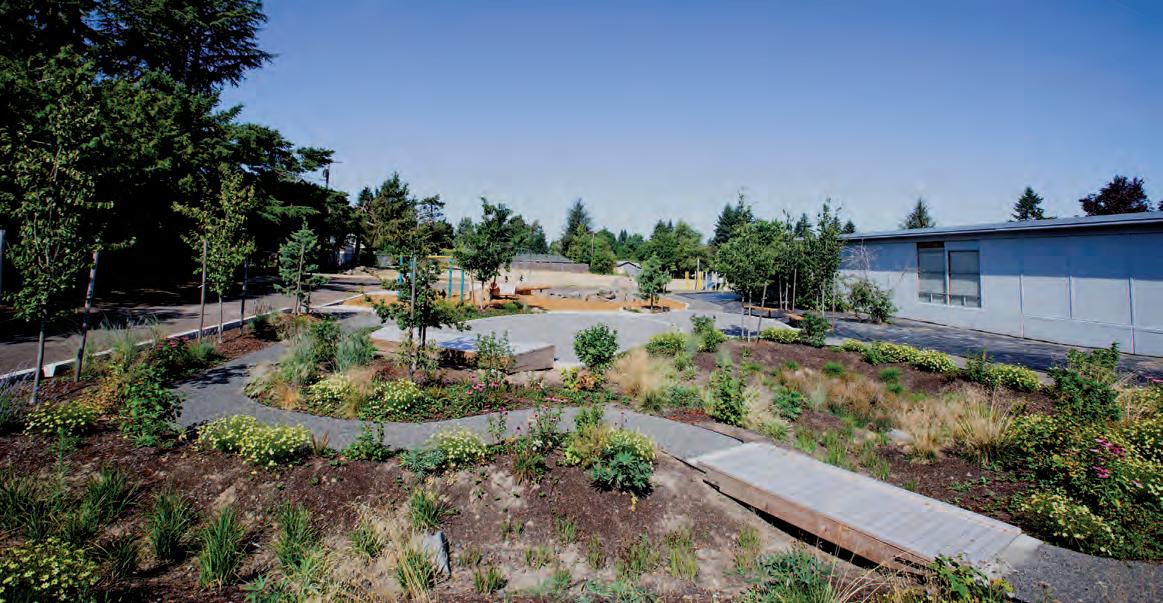
Chelsea, Massachusetts
The tiny 2.5 square mile town of Chelsea might not have the relentless heat of Phoenix, Arizona, but there’s one block at least for which summer heat is magnified, often 20° hotter than elsewhere, according to data collected by Boston University, which placed temperature sensors in trees and on roofs. The problem? “A lot of asphalt and concrete,” says Maria Belen Power, Associate Executive Director of Green Roots in Chelsea, which focuses on environmental justice. “When folks are experiencing average summer days in our region, our community in Chelsea is experiencing much hotter temperatures…that exacerbate public health concerns like upper respiratory illnesses [and have] real consequences on people’s lives,” she says.
Green Roots chose one block to revitalize, consisting of a vacant lot, a Boys & Girls Club, 10 multifamily dwellings, parking lots, and five trees. Five. And asphalt. Lots and lots of dark asphalt.

The plan included removing much of the asphalt and replacing it with open green space and trees, and covering the roof of the Boys & Girls Club with white reflective coating. The project enlisted the city of Chelsea, the Department of Public Works, and the Boys & Girls Club, all working together. “Including
the folks that are most impacted by the issue is a critical part of our work,” Power says. “We wouldn’t be doing this project without the residents that live on that very same block.” Consequently, residents were invited to share their ideas of what they wanted, including a design contest to reimagine the space.
While the work continues to be underway, to date the block has 47 new trees — crabapple, cherry, elm, and hawthorn. Sidewalks have been replaced with planters, porous paving stones, or white concrete. Where asphalt is necessary, it is gray rather than black.
Success is measured not just in how many degrees cooler the space becomes but also the impact on people’s emotional state, their mental health. “How do people feel who live there, who work there, who walk around there? That’s pretty critical,” Power says.
Power is acutely aware that this is one block in one small city in one state. But these hyperlocal projects matter, she says, and they create templates that can be replicated. “It gives us a lot of hope that we can create incremental change and we can improve public health.” But that, of course, is not enough, she says. “Hyperlocal pilots like this alone are not going to move the global needle. We need to be addressing climate change, at every level.”
WHAT'S SO BAD ABOUT PAVEMENT? • FEATURE 36 MARTHA’S VINEYARD /SUMMER 2022
A recent depaving project at Powell Butte Elementary in the Centennial School District of Portland, Oregon, saw the removal of 7,400 square feet of asphalt and the addition of roughly 750 plants.
PHOTO COURTESY OF DEPAVE

37 marthasvineyard. .com Member FDIC | Member DIF mvbank.com support something great.
Every day we are committed to working with the community to inspire action that helps preserve our home and our precious natural resources. Get involved at local.mvbank.com The Art of the Great Ponds Opening Reception August 12th at 5:30 pm Martha’s Vineyard Bank 517 South Road, Chilmark Exhibit runs from August 12th through September 1st
Photograph courtesy of Alison
Shaw
In Search of
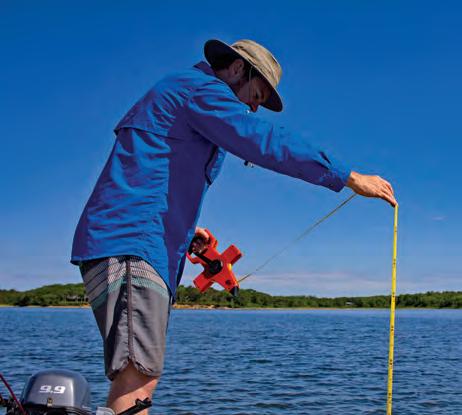
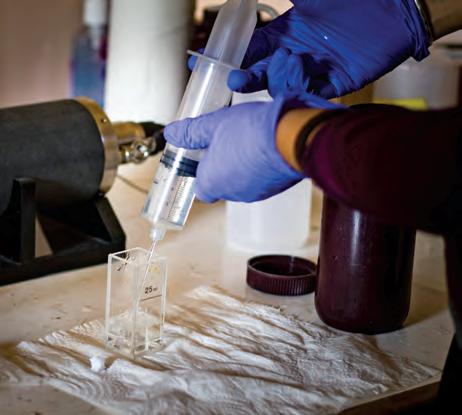


IN SEARCH OF GREATNESS • FEATURE 38 MARTHA’S VINEYARD /SUMMER 2022
Scientists from the Great Pond Foundation are hard at work conserving the Island's Great Ponds.
Greatness
The Art and Life of Martha's Vineyard's Great Ponds
What is a great pond?
Iknow, you know. A nice big pond on the coast of Martha’s Vineyard. Brackish, surface glimmering and tame, dune-sheltered against a roaring south shore ocean. Its coves reach like fingers northward, their pinched ends holding still water. Home to osprey, otter, eelgrass, artist. Site of Island rituals: the opening of the cut, the catching of the bass, the long walk to the beach.
But what the hell is a great pond, technically?
I’ve lived on the Vineyard, spoken with experts, and looked in history books, and I’m only getting more confused.
The ponds that bear the title — the Edgartown and Tisbury Great Ponds — come first to mind. Another criterion for their “greatness” might be how much of the Island they cup in their palm, and these two together drain about 30% percent of the Island’s land area — they receive more water than what flows into the sea.

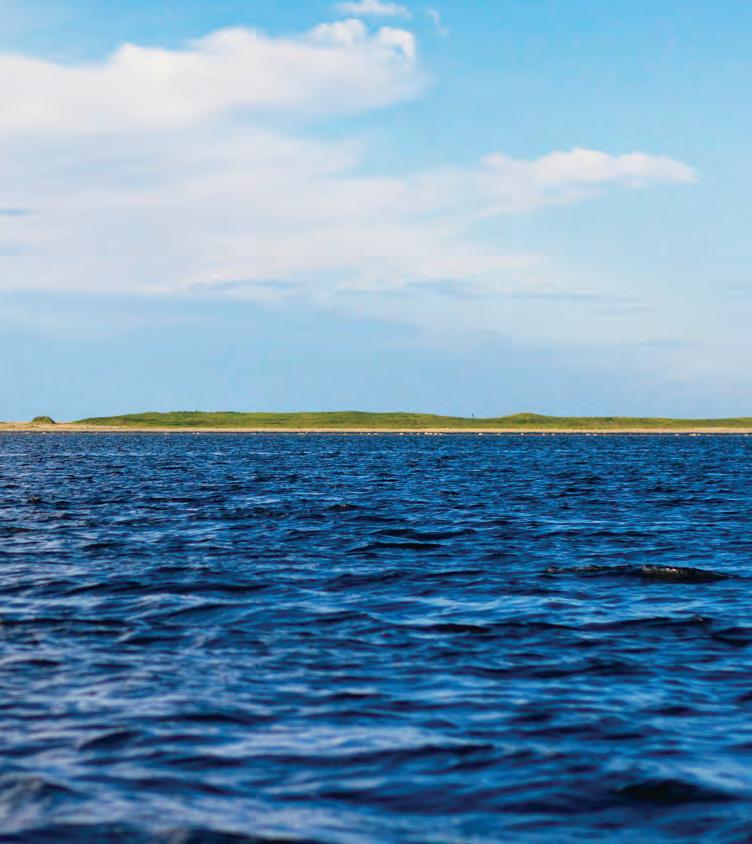
But Paqua Pond is a great pond, too. It covers
14 acres in Edgartown, around 60 times less than its largest neighbor. Its watershed includes its immediate surroundings and little else.
As I look, there are 16 ponds on the Island that are recognized as great ponds by the law of the land, which happens to be a short list maintained by the Massachusetts Department of Environmental Quality.
The list includes more ponds and coves on the South Shore. Together they resemble outstretched hands, palms down on the salty southern barrier beaches and fingers pushing up the frost bottoms of the Island’s great outwash plain. Notably, Quenames and Crackatuxet Coves don’t make the list.
Menemsha Pond, though indisputably one of the greatest Island ponds, is not technically a great pond. Crystal Lake in Oak Bluffs might be better labeled a soup than a pond, going by recent water quality analyses. At 12 acres, it is nevertheless a great pond.
39 marthasvineyard. .com
FEATURE • IN SEARCH OF GREATNESS
Story and Images (except where noted) by Sam Moore
The Code of Massachusetts Regulations says that a great pond is “any pond which contained more than ten acres in its natural state, as calculated based on the surface area of lands lying below the natural high water mark.” But snubs are handed out to several ponds that seem to be over 10 acres au naturale (see box).
In my effort to clarify the criteria, I became entangled in a fairly circular email exchange with the DEP’s Waterways Program. My article “should not try and ‘interpret’ the regulations or make any assessments of why certain ponds are named as Great Ponds vs. others,” they instructed me. In fact, they wrote, “DEP also does not ‘interpret’ the definition. Any pond that meets the definition of a Great Pond is a Great Pond.”
They also categorically stated that “great ponds are not tidal waterbodies.” I had a hard time not “interpreting” this one, since Oak Bluffs Harbor and Farm Pond are certainly so, and several others are tidal periodically, when their connection to the sea is restored.
In 1996, when the state went countyby-county and made this list, it was by its own admission not an exhaustive
effort. New water bodies can be added via a “request for determination of applicability.”
Semantics aside, why does it matter what a ‘great pond’ is? The conversations around these ecosystems often refer to them by other categories, as estuaries, embayments, coastal ponds, or kettle ponds. The Massachusetts Estuaries Project, a regional effort to conserve these places, includes ponds you might have been skimming this article for in vain — Tashmoo, Lagoon Pond, and Sengekontacket get their due here, as does Menemsha.
Well, the title of ‘great pond’ does carry legal weight, enshrined in law with remarkable continuity since the colonial ordinances of the 1640s, before the Vineyard was even part of Massachusetts. Ponds over 10 acres remain in the public trust, and “shall be free for any man to fish and fowl there, and may passe and repasse on foot through any mans [sic] property for that end.”
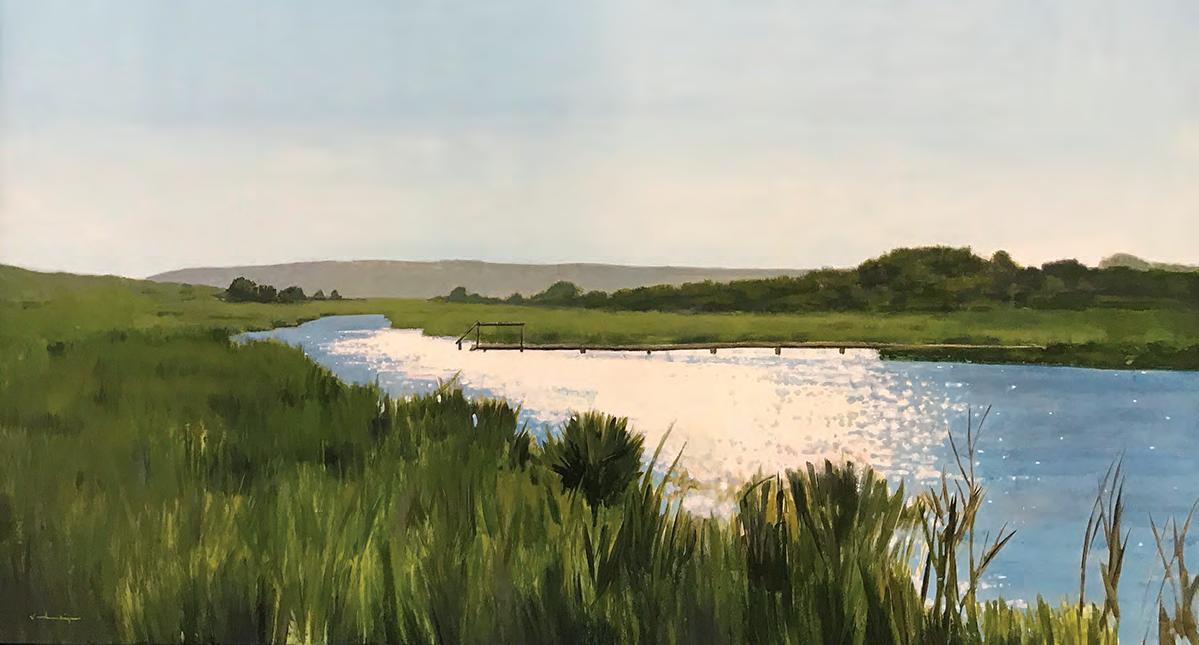
The question of what you can do with your right to this trust has been hotly litigated — in an important case in Fall River in 1888, it even split the opinions of famous friends and future Supreme
Court justices Louis Brandeis and Oliver Wendell Holmes.
Often in question was the effect of textile mills, dams, and public water supplies on other pond users. In 18th century Fall River, a soap company on the town’s great ponds spent twenty years boiling dead horses and cows and pouring the results into the public trust. Judging by the public’s olfactory response, their trust had been violated.
Other 1800s cases were actually about ice — who can cut it, take it, and sell it. In West Roxbury, for example, some Jamaica Pond residents, “without permission, and in the face of express prohibition from the town, proceeded to cut and carry away ice as merchandise.”
In 1863, the court responded with a delightfully expansive list of public rights on the great ponds, which included: “Fishing, fowling, boating, bathing, skating, or riding upon the ice, taking water for domestic or agricultural purposes or for use in the arts, and the cutting and taking of ice.”
People on the Vineyard used to exercise their ice skating rights a lot more. One account claims that, because the south shore ponds used to be more
IN SEARCH OF GREATNESS • FEATURE 40 MARTHA’S VINEYARD /SUMMER 2022
Chilmark Pond, acrylic on canvas, by Dan VanLandingham.
Official Great Ponds
Edgartown Great Pond
Tisbury Great Pond
Squibnocket Pond
Chilmark Pond
Oyster Pond
Long Cove Pond
Black Point Pond
Job’s Neck Pond
Watcha Pond
Trapp’s Pond
James Pond
Big Homer’s Pond
Farm Pond
Oak Bluffs Harbor
Paqua Pond
Crystal Lake
connected by open water, you could travel on blades of steel alone from the Tisbury Great Pond to Edgartown, or from Long Point to Chilmark Pond.

“This is the biggest of the ponds we sample,” Reddington said, “and it’s also the longest running, so we have more of an intimate knowledge of it.”
Cape Poge Pond
Sengekontacket Pond
Lagoon Pond
Tashmoo
Eel Pond
Pocha Pond
Nashaquitsa Pond
Crackatuxet Cove
Caleb’s Pond
Upper Chilmark Pond
Stonewall Pond
Middle Point Cove
Duart’s Pond
Job’s Neck Pond, East
Quenames Cove
Harlock Pond
Brush Pond
Squibnocket Ridge
Seth’s Pond
Ice House Pond
Daggett’s Pond
Wondering where all these ponds are? Check out our online map at marthasvineyard. bluedotliving.com
From that perspective, what makes a great pond great might be its outsized role in the nature and culture of the Island — as a place where people and creatures gather, where the small Island meets the infinite sea, and where the processes of change that shape sand and life march relentlessly forward.
Ecosystems in flux
At seven o’clock on a glassy morning, in the garden-fresh air after a rainy night, Julie Pringle (Bluedot’s spring Local Hero) is nosing a small boat up to a sandy landing on the Edgartown Great Pond. Although it’s June, the pond is quiet — the buzz of outboard motors and landscaping equipment dormant for now.
Preparing to hop in, with bags and boxes of gear, are Emily Reddington and David Bouck. With Pringle, they’re taking the most comprehensive water samples of the pond to date: several times a week, all summer long. Their organization, the Great Pond Foundation, was created to conserve this pond, but their monitoring programs and advisory help have expanded to the Tisbury and Chilmark ponds too.
We’re on the water to get a snapshot of how the pond is doing. Not only whether it’s safe for people — a primary concern for everyone involved — but whether it’s supporting the wider network of life that depends on it. At their best, these ponds are hatcheries, nurseries, enclaves, and buffets, depending on your place in the food chain. At their worst, they can become toxic for people and animals, a severed
FEATURE • IN SEARCH OF GREATNESS 41 marthasvineyard. .com
At the heart of all this monitoring work, and the restoration and management that follows, is an attempt to reckon with change. Some of it is inevitable, sure, like the flow of tide and sand that’s pushing the south shore north. Other kinds of change threaten to further unravel the qualities that made the Island worth living on in the first place: sites (and sights) of almost unimaginable richness.
Not-so (officially) Great Ponds that are still wonderful (and more than the requisite 10 acres)
The Great Pond Foundation crew collects water samples from Island ponds.
link that snaps the whole chain loose.
The health of the great ponds is the subject of great interest and strong opinion. In these waters, I am learning, science is a crucible on which Yankee folk wisdom can die or be reborn.
A surprising amount is reborn. Andrew Jacobs, who manages the Wampanoag Environmental Laboratory in Aquinnah, told me, “There are so many people who are so in tune to this Island. They don’t realize how important their
observations are. What they’ve seen, what they’ve told us, we’ve been able to confirm through scientific analysis.”
Sure, some notions, like the idea that waterfowl are the main source of nitrogen in large ponds, don’t hold up to isotopic study. It’s easy to speculate until a team of world-class scientists shows up. After that it’s numbers, more numbers than you had maybe hoped to see.
The numbers involve nitrogen, phosphorus, salinity, dissolved oxygen,
Sea Clams, oil on linen, by Andrew Moore. See Moore's gallery show this month at the Moore Family Gallery in Harthaven moorefamilygallery.com
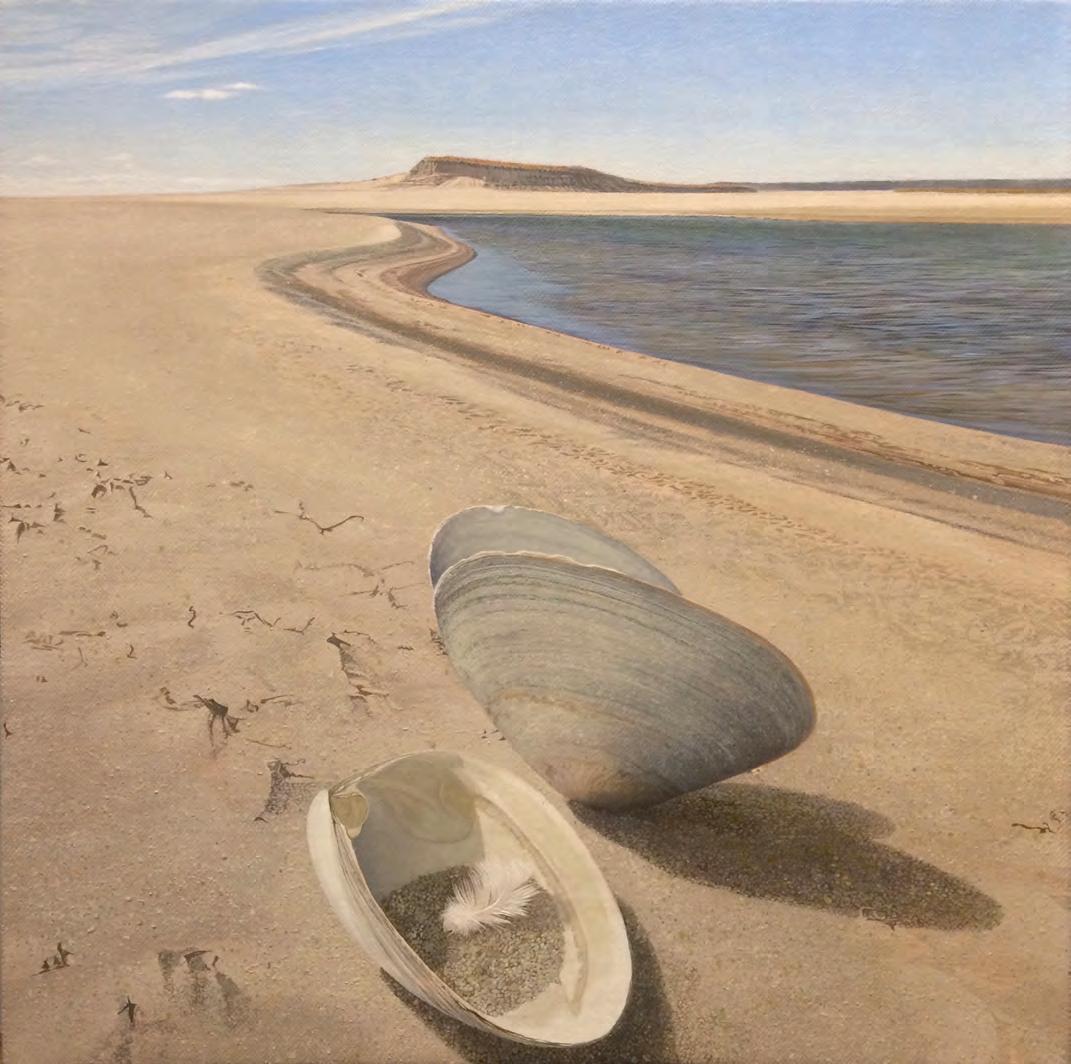
IN SEARCH OF GREATNESS • FEATURE 42 MARTHA’S VINEYARD /SUMMER 2022
"Looking west toward Chilmark from the east of the West Tisbury Great Pond opening."
phytoplankton, and real estate.
They show up in emails, then maps and beach closures, then reports, then planning meetings, town meetings, and then lawsuits. But first, they arrive aboard a small outboard skiff on one pond or another, often tapped into a purple iPad owned by the Great Pond Foundation.
The Foundation is not alone in this work. The Martha’s Vineyard Commission takes their own periodic read on the ponds, and Jacobs and his colleagues at the Wampanoag Environmental Lab not only study up-Island water bodies but process water samples for almost everyone else on the Island.
Jacobs works with data from Menemsha and Squibnocket that goes back decades. “There’s a bunch of different ways that you can look at the same data set to try to understand what the health of a water body means,” he told me. “We do all of our analysis here in house. Bacteriological, dissolved oxygen, temperature, salinity, conductivity.” They study how this data “relates to not only environmental health and human health, but how it relates to the health of sustenance foods and resources.”
These ponds are immensely productive when the balance is right, and in good
years sustenance can include herring, quahogs, and scallops among many other foods long accessed by Wampanoag people. In years where excess nutrients wash and plume from human settlement into the water, what flourishes are frenzies of phytoplankton, microscopic marine plants that bloom and quickly die, depriving the water of oxygen, blocking sunlight, and sometimes producing very toxic compounds.
A great pond thrives as a meeting of land and sea — too much of one or the other and it leaves the zone where its characteristic species do well. Pringle describes the pond like a sommelier. “We prefer it to be on the saltier end,” she says, taking a meter reading in parts per thousand. “This is 16, which is brackish. The ocean is about 34, freshwater zero. So we’re really right in between.”
“We’d love to see dissolved oxygen above six milligrams per liter,” Reddington added. “Those are the EPA standards, those are the Mass Estuaries Project standards. Once you start to get below that, down to about four, that’s not ideal. Certain things will have to swim out of the area. Once you’re below two, that’s where it’s critical. If you get between two and zero, it’s bad.”
For a layperson, here’s an indicator of how a pond is doing: “If you can see down most of the year to three meters, that’s a good thing,” Reddington said. Clear water means less organic material is clouding things up, which means that excess nutrients like nitrogen haven’t been spurring their runaway growth. (See Bluedot’s 2021 story on nitrogen here: bit.ly/so-bad-nitrogen.) It also means eelgrass, a cornerstone species in this pond, has enough light to grow in the deeper, cooler water.
The Edgartown Great Pond has more eelgrass than you might expect. It’s been on a rebound, enough so that visiting scientists are surprised that the numbers add up. “For the amount of wastewater coming in, we should not have the grasses that we do,” Reddington said.

These submerged aquatic meadows are a boon for biodiversity, carbon sequestration, and water quality. The eelgrass improvement in the Edgartown Pond is a testament to judicious use of the Island’s most readily available management tool — the cut.
Opening a coastal pond to the sea allows a salty flush of the whole system. It’s a tradition dating back to the hand-dug cuts made by the Wampanoag (the cut on
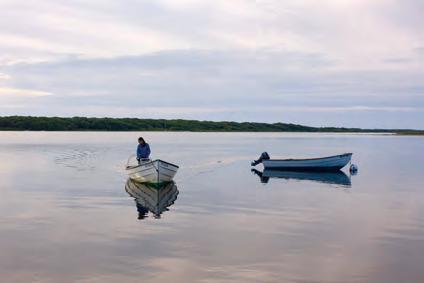
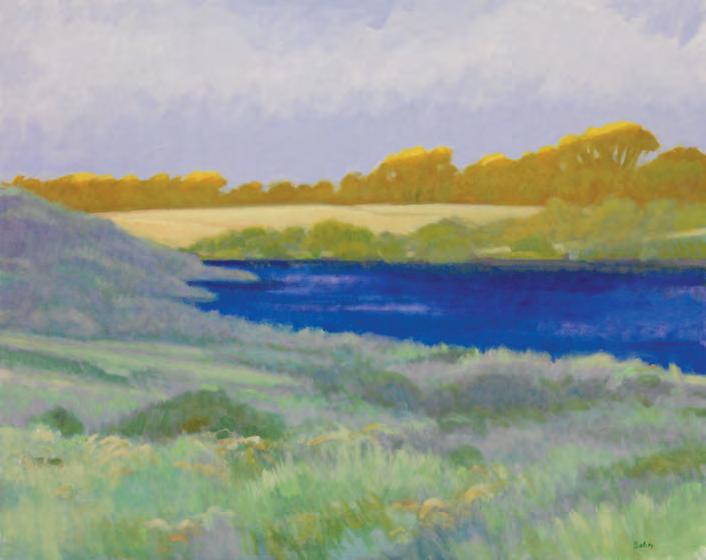
FEATURE • IN SEARCH OF GREATNESS 43 marthasvineyard. .com
Monitoring the health of eelgrass.
When Sun Broke on Chilmark Pond, oil on canvas, by Leslie Baker.
What You Can Do
Six Steps to Preserving our Ponds
Excess nitrogen in the water feeds algae blooms harmful to wildlife, people, and pets. In 2022, the Great Pond Foundation and the Marine Biological Laboratory sampled the Edgartown and Tisbury Great Ponds, and Chilmark and Crackatuxet Ponds and found that approximately 51 to 58% of the nitrogen comes from wastewater, 21 to 27% from fertilizers, and 17 to 21% from atmospheric sources, with birds typically contributing a miniscule 1% or less. (For details, visit the Great Pond Foundation website.)
What we do on the land affects the nearby water. With the Vineyard’s sandy soils, chemicals and fertilizers leach into our groundwater that flows into our ponds and wells.
Grow a Vineyard lawn
Embrace a lawn that is a mosaic of more drought tolerant grasses, mosses, and native plants, and is safe for your family. Cut it to a height of three inches and leave the clippings on the lawn for a natural fertilizer. Don’t use lawn chemicals or synthetic fertilizers; much of this leaches through our sandy soils and ends up in the groundwater. Fertilize lightly with compost in the fall. For Vineyard lawn tips, visit the Vineyard Conservation Society website.
Reduce your lawn size
Try having a small mowed area around the house and maybe an area to play in, but let the rest grow
into a sweeping meadow. The base of the grassland meadow could be little bluestem grass, butterfly weed, Asters, and other native flowers. Mow winding paths to the water, your garden shed, or pool. To maintain the meadow, mow high once in the winter/early spring (to protect ground nesting birds), leaving the clippings on the ground to reseed.
and structure over the four seasons. Ninety percent of the world’s sandplains grasslands are on the Cape and the Islands — let your yard add to this incredible landscape. You will be rewarded with a world of butterflies, fireflies, songbirds, buzzing bees, and more.

Use the resources on-Island
Butterfly Weed
Have a native plant expert from BiodiversityWork’s Natural Neighbors program visit your yard to give you tips on what to plant, how to support wildlife, and native plant kits to buy. Polly Hill Arboretum sells Island native plants, as do some nurseries. Learn about native sandplain grasslands through a Nature Conservancy webinar. Use landscapers who are familiar with environmentally friendly practices or share these resources with your current landscaper. Support nonprofits that work to keep our ponds healthy.
Support land preservation efforts
Create or leave a vegetative buffer
Between the water’s edge and your lawn, leave a large natural vegetative area of 10 to 100+ feet. The root systems will bind the soil preventing erosion, soak up nitrogen, and help filter out other contaminants.
Add MV native plants
Native Vineyard plants need little, if any, watering. They also offer an attractive changing color palette
Land is the best buffer to absorb excess nutrients and chemicals that could flow into the ponds. Intact native landscapes can filter and prevent 75% or more of the nitrogen from entering our ponds. Affordable housing is a critical need on the Island and it can go hand-in-hand with land preservation efforts, smart growth, and ecological integrity. Support non-profits that are protecting the unique natural habitats on our Island.
–Anne Mazar
Anne Mazar is a board member of the Great Pond Foundation and lives alongside the Edgartown Great Pond. See the story of her house, and the restoration of the native sandplain here: bit.ly/Great-Pond-House.
IN SEARCH OF GREATNESS • FEATURE 44 MARTHA’S VINEYARD /SUMMER 2022
James Pond is still dug this way). When I went out in late June, the opening on the Edgartown Pond had recently closed, naturally sealed by the movements of sea and sand.
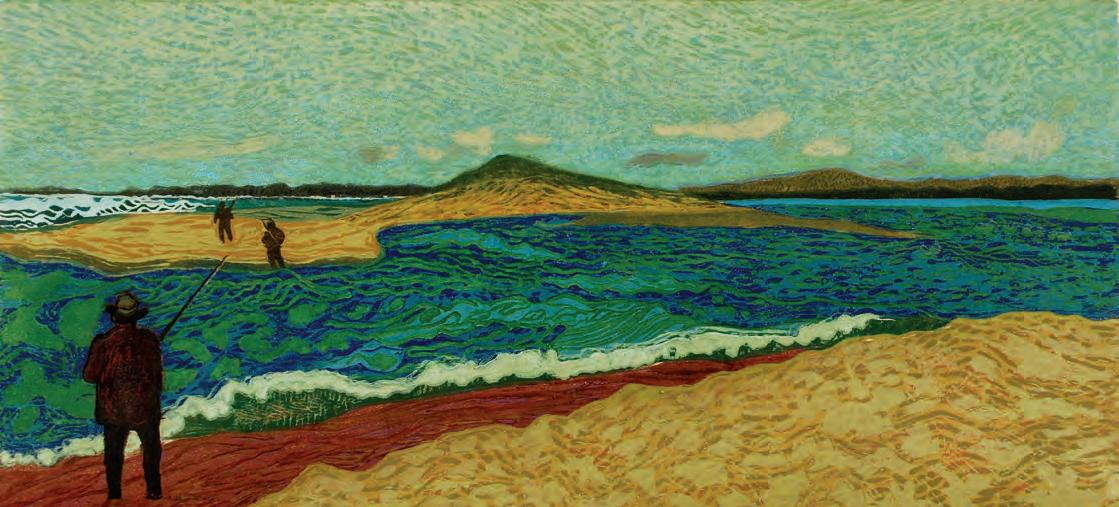
“We always get excited when we have a long successful cut because then the salinity goes up into the 20s,” Pringle said. “Didn’t quite get up that high, but it’s 16 right now.”
“Better than where it was before,” said Reddington. It had been eleven and a half, very near the lower limit at which eelgrass can survive.
By taking water samples precisely and often, the Great Pond Foundation can observe the changes wrought by these brief openings in granular detail. “If the cuts didn’t happen, this pond would not be nearly as healthy as it is,” said Reddington.
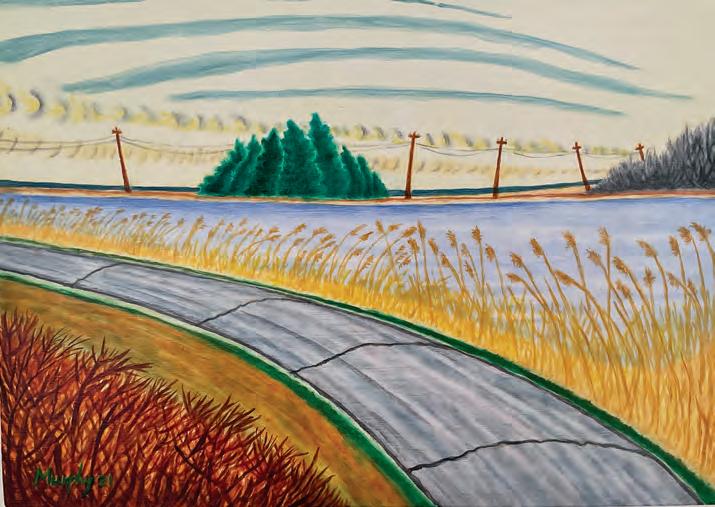
The timing of a cut is a delicate dance. Reddington said, “It might benefit water quality and eel grass but it might not be the ideal time for spawning herring to get in and out.” Or maybe the pond is high enough, and the ocean low enough for a strong cut to form, but other factors aren’t ideal. “Which things do you optimize for? To do it well takes a lot,” she said.
As we neared a patch of eelgrass that’s been expanding steadily since 2016, Reddington attributed its growth to “a
FEATURE • IN SEARCH OF GREATNESS 45 marthasvineyard. .com
Opening a coastal pond to the sea allows a salty flush of the whole system. It’s a tradition dating back to the hand-dug cuts made by the Wampanoag — the cut on James Pond is still dug this way.
Farm Pond, oil by Laura Murphy
Fishing the Cut, Woodcut by Ruth Kirchmeier.
general reduction in nitrogen, but also an increase in the flushing capacity with each opening, with consistent dredging and well-timed openings. The combination of the two gets that flush up into the coves more consistently.”

Lest it be said that eelgrass doth great pond make, many of the other ponds don’t have it — either because of water quality or relative freshness; some are just different habitats.
Tisbury Great Pond has a stronger freshwater influence on account of the Tiasquam River and Mill Brook, said Bouck, something of a pond sommelier himself. “You’ve got these two tributary
IN SEARCH OF GREATNESS • FEATURE 46 MARTHA’S VINEYARD /SUMMER 2022
South Shore Ponds, Winter, by Sam Moore.
What makes a great pond great might be its outsized role in the nature and culture of the Island — as a place where people and creatures gather, where the small Island meets the infinite sea, and where the processes of change that shape sand and life march relentlessly forward.
streams that start in Chilmark and travel all the way down through this watershed.” Throw in more agriculture, no town sewer system, and all the other variables that make it unique, and you’ve got “roughly the same size pond, roughly the same area of watershed but very different inputs,” he said.
Edgartown Great Pond has few natural streams of any size, so it’s mostly groundwater coming in. Even so, Pringle added that “Edgartown used to be a fresher pond, back when there was a herring fishery. Herring like freshwater, and now it's more managed for the shellfish and the eel grass.”
Coastal ponds with less ocean influence have a harder time coping with excess nutrients. For example, Jacobs at the Wampanoag lab told me, “Menemsha is a reasonably healthy pond. Squibnocket on the other hand, is not. It’s really struggling.” The only refreshing dose of salt water comes to Squibnocket from a single culvert to Menemsha pond, and the occasional overwash of its oceanfacing shores. It suffers from poorer water quality as a result, and has already had harmful cyanobacteria bloom watches issued this summer.
So each pond has its own balance sheet — nutrient inputs balanced against how often the pond is flushed, its size, its expected cultural use, and many other factors. The research part is just making sure we can read the sheet.

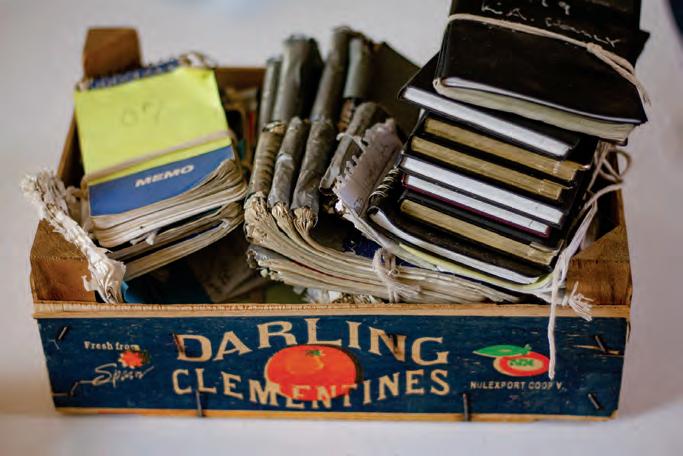

Remembering the greats
At the heart of all this monitoring work, and the restoration and management that follows, is an attempt to reckon with change. Some of it is inevitable, sure, like the flow of tide and sand that’s pushing the south shore north.
Other kinds of change threaten to further unravel the qualities that made the Island worth living on in the first place: sites (and sights) of almost unimaginable richness.
FEATURE • IN SEARCH OF GREATNESS 47 marthasvineyard. .com
The GPF'S Dave Bouck shows data collected by Islanders over decades. The Foundation is digitizing all the records.
Bouck, Watershed Outreach Manager at the Great Pond Foundation, said, “my parents remember a time when they could canoe back and forth between Tisbury Great Pond and Long Cove Pond.”
He grew up on the Tisbury Great Pond, and these days he’s thinking a lot about memories, because he’s in the process of preserving thousands of them from Islanders who have their own tradition of keeping an eye on things.
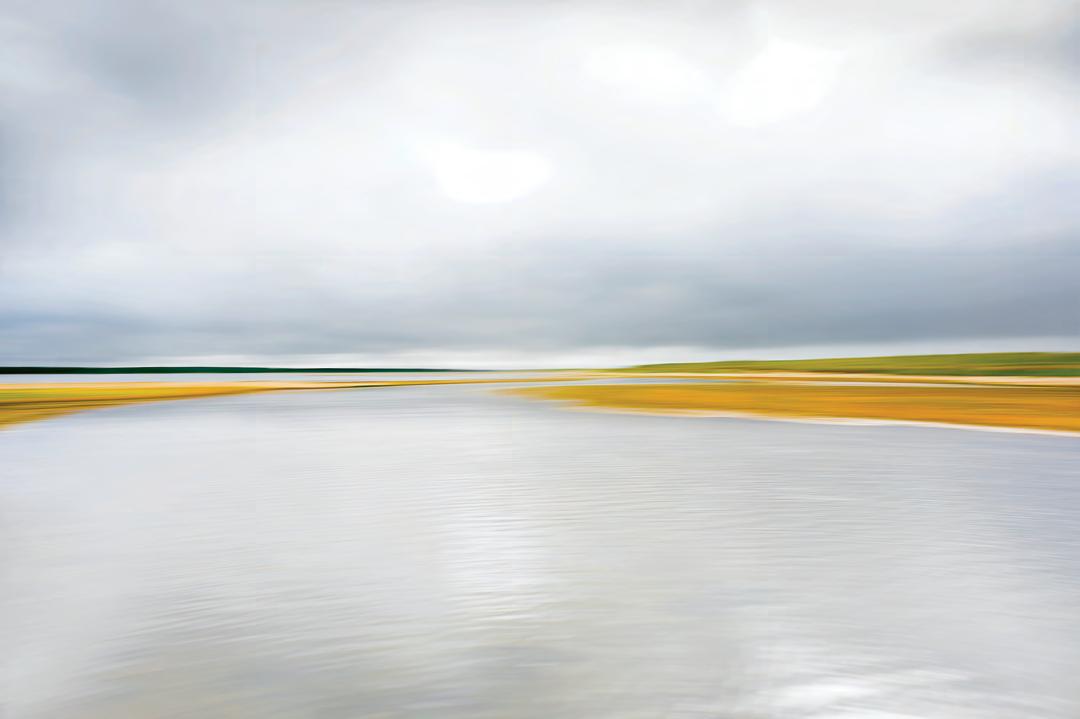
“They've been recording data, in many different forms at many different times for their entire lives,” Bouck said. “So you just have this massive data set around that pond, just due to the culture of the area. But a lot of it exists in journals or notebooks or handwritten spreadsheets, observations, poems, photos, or just in their opinion.”
Using a grant from the Martha’s Vineyard Community Foundation, he’s digitizing one of the Island’s longest running citizen science projects — decades of water monitoring data from
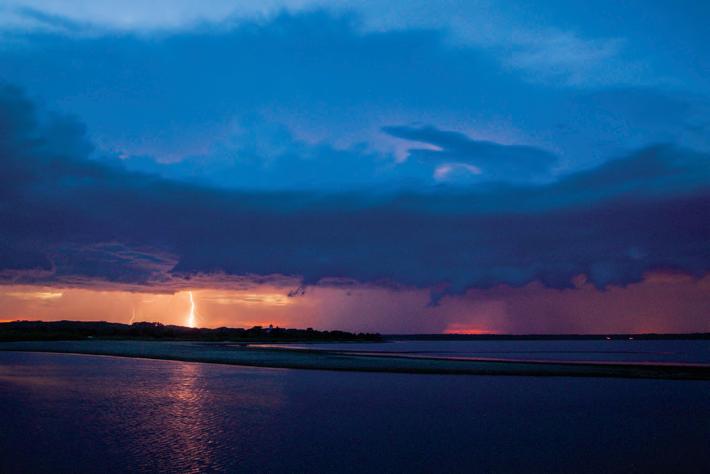
riparian owners and other Islanders on the Tisbury Great Pond.
The project began in collaboration with the late Kent Healy (see our story here: bit.ly/Kent-Healy), civil
engineer, water-quality aficionado, pond commissioner, and West Tisbury selectman, whose meticulous records of hydrology on the Tisbury Great Pond spanned decades. After Healy suddenly
IN SEARCH OF GREATNESS • FEATURE
48 MARTHA’S VINEYARD /SUMMER 2022
Lightning over Oak Bluffs, photograph by Sam Moore.
Tisbury Great Pond, 2016 by Alison Shaw.
passed away last October, the project gained more urgency.
“It kind of turned into, ‘Okay, we need to first of all get in and preserve everything that he ever did,’” Bouck said. He’s nearly finished digitizing the main records. “We figured out it’s about 30 minutes per book,” he said. “And there are 60 books.” He produced a box of worn notepads, crammed with details of rainfall, pond height, and stream flow.
“I’m the wind, rain, and gravity guy,” Healy is recorded saying in Ollie Becker’s new film, On Our Watch. He goes on, “You want to know what's going on? Measure the rainfall, measure the flow in the brooks, measure the elevation of the pond, measure the groundwater. Keep track of stuff.”
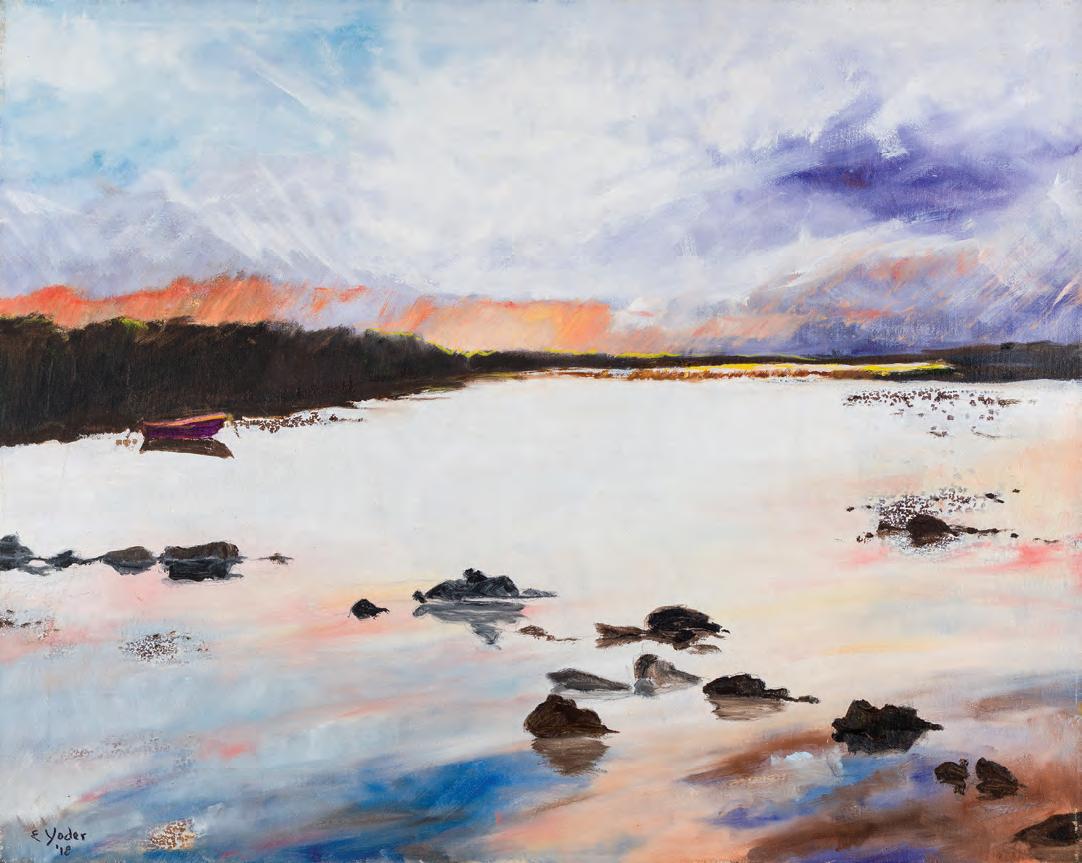
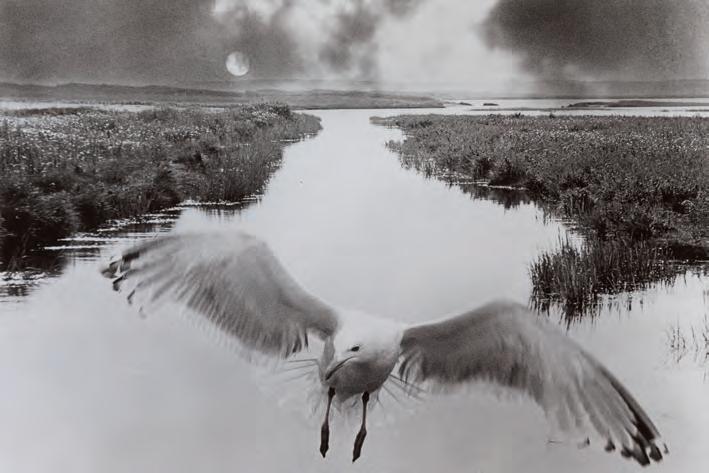
FEATURE • IN SEARCH OF GREATNESS 49 marthasvineyard. .com
Squibnocket Sunset, oil on canvas, by Edith L. Yoder, Courtesy of the M.V. Hospital's Permanent Art Collection.
Crab Creek Tisbury Great Pond, by Barbara P. Norfleet, Courtesy of the M.V. Hospital's Permanent Art Collection.
The late John MacKenty was another Islander who collected pond data, recording elevation consistently from his dock on Wintucket Cove on the Edgartown Great Pond for more than 30 years. His data was incorporated into local and state management “because it was the best data set that was here,” said Reddington. MacKenty’s son, Ed, has carried on the tradition from Wintucket Cove, this time with real-time digital monitors provided by the Foundation.
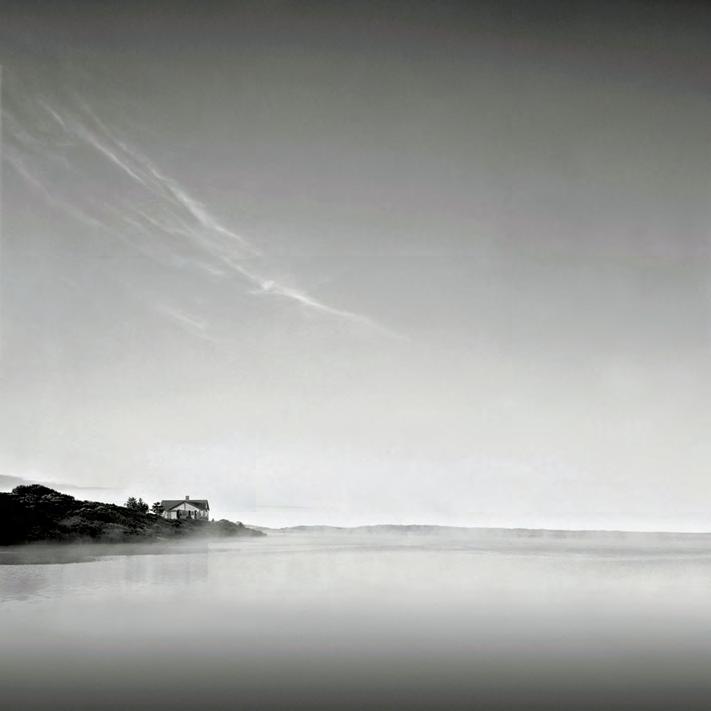
This multigenerational tradition of keeping vigil on the ponds is one of the only glimpses we have at whatever the ‘natural state’ of these ponds has been over the years.
Reddington said, “It’s continuing traditions, it’s keeping the data alive and it’s the community working together to help the ponds.”
About the Edgartown Great Pond, she said, “generations of people have cared about this pond, which is one of the reasons it's turned from something that was pristine into something that
was struggling with regular algal blooms into something that's now considered a restoration success story. The work is not
done here.”
There are solutions to what’s afflicting the great ponds, and hopefully the will to tackle them, too. Conserved land, carefully managed development, and clever septic all have some role to play.
As I found when I sought answers in the official list of great ponds, not a lot of Vineyard ponds technically make the cut. Fortunately for those who live here, the cut is one thing that Islanders are very good at making themselves.
Editors’ note: Sam Moore will continue his investigation into Martha’s Vineyard Great Ponds with a story on salt marshes in our October issue.
See more Art of the Great Ponds at marthasvineyard.bluedotliving.com, sponsored by Martha's Vineyard Bank. If you love great ponds, you’ll love the Art of the Great Ponds exhibit at MV Bank's Chilmark Branch, curated from the M.V. Hospital's collection by Monina von Opel. Show runs from Aug. 12 to Sept. 1, with an opening reception on Aug. 12 at 5:30 p.m. The reception will include excerpts from Ollie Becker's Great Ponds documentary film, and a conversation with the filmmaker.

IN SEARCH OF GREATNESS • FEATURE 50 MARTHA’S VINEYARD /SUMMER 2022
Quansoo Tuned, Looking West to The Schoolhouse, by Lanny McDowell.
Sunrise Over Chilmark Pond, by David Fokos.

FEATURE • IN SEARCH OF GREATNESS 51 marthasvineyard. .com
The Iris Room, watercolor, by Hannah Moore.

RIGHT AT HOME • FEATURE 52 MARTHA’S VINEYARD /SUMMER 2022
Emily and Steve Solarazza in the kitchen of their Vineyard Haven home and details from the solar, straw-bale structure.
RIGHT AT HOME:
SunVineyardPeopleHaven The of
Emily and Steve Solarazza are really committed to solar power.
When I walk up to Steve and Emily Solarazza’s 600-square foot Vineyard
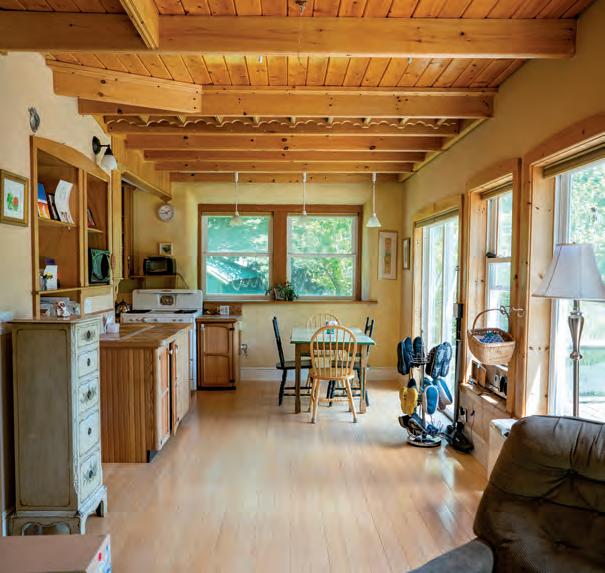
Haven home on a sunny June afternoon, they greet me on their front deck, where they are roasting two sweet potatoes in a solar oven. They tell me it takes several hours for the potatoes to cook in a solar oven versus the one hour it takes in a conventional oven. As we say our initial hellos, I think to myself, “Wow,
that’s a super strong commitment to using solar energy.”
I have been on a “How are you? How are the kids?” social basis for years when I run into Steve or Emily at the market and in town but I have never been to their house. And until I began chatting with them in more depth, I had no sense of just how much solar power (and the sun) means to them: They tell me when they got married, they changed their names to
Solarazza, which means “sun people.”
Steve, who is 68, and grew up in Hyde Park, Mass., is a fine carpenter. Emily, 48, is from Westchester, New York, and is a massage therapist and yoga teacher. They met on the Island and have been together for 17 years. “We were best friends first,” Steve says, smiling.
As they show me around the house, Steve points out his favorite details. The curve of the walls by the windows to let

FEATURE • RIGHT AT HOME 53 marthasvineyard. .com
Story by Mollie Doyle Photos by Jeremy Driesen
more light in. “He loves curves,” Emily says. Steve flips a switch, moving his “coat elevator” into vertical action. The coat elevator lifts a rack of coats up toward the ceiling, increasing storage. They tell me that because of their use of solar power — panels, passive solar, other heat trapping and cooling technologies, and the way the house itself is built — they only spend about $200 a year on utilities. A family of four living year round, doing laundry, bathing, cooking, heating, living, and only spending $200? Amazing.
Steve explains that while the home’s solar panels help them harvest and use solar energy, because the house itself is insulated with straw bales, it increases the home’s ability to hold heat in the winter and stay cool in the summer. “The walls
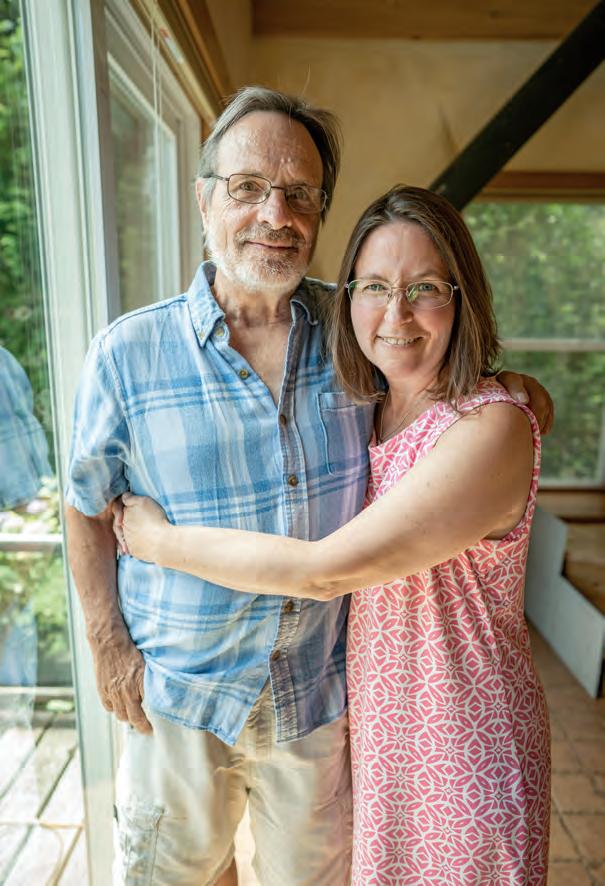
are two feet deep.” He laughs,“We have an R-value of 60.” For those not familiar with R-values, this is the term used to measure a home’s insulation performance. For comparison, a typical newer home on the Island might have walls with an R-value of 23 and a roof R-value rated from 38 to 49. So an R-value of 60 is astounding. Unlike many insulations, straw is also non-toxic, an agricultural byproduct and completely compostable.

Steve explains that he had been fascinated by straw bale homes when he discovered that Paul Lacinski, author of Serious Straw Bale: A Home Construction Guide for All Climates, and an expert on building straw bale homes in colder climates, lives in Ashfield, Mass. In 2005, Steve reached out and Paul said he would
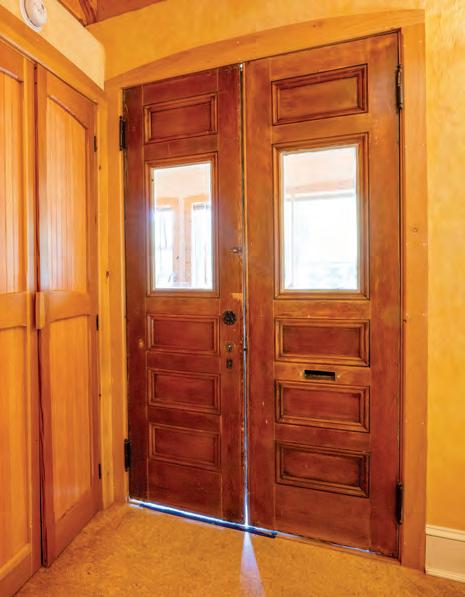
RIGHT AT HOME • FEATURE 54 MARTHA’S VINEYARD /SUMMER 2022
“We tried to use straw from Chappy to keep the supplies even more local,” Steve says, “but it was too damp. We ended up using straw from Newburyport.”
be happy to help Steve build one. While some straw bale homes use the straw to bear the load as well as insulate, Steve and Emily opted to put in a foundation, build a “super structure” or stick frame with wood and then fit the straw bales into the frame. “We tried to use straw from Chappy to keep the supplies even more local, but it was too damp. We ended up using straw from Newburyport,” Steve says. “You do not want any moisture in the straw that leads to mold and a host of problems,” Emily adds.
On Memorial Day weekend in 2006, “A couple hundred bales of straw were delivered. And we went to work,” Steve laughs. The event had a barn raising feel. “So many people showed up to help us,” Emily adds. “Jennifer Johnnson, Oceana Rames, Ozzy Martins, Donald Cronig, Steve’s brother Fred Ruzanski, and Debbie Hart. We’d fit the straw into the frame
and then stake it and tie it right to the frame.” Had I not seen the video (bit.ly/ Bena-straw-bale) of this that my husband, Thomas Bena, shot while making his film One Big Home, I would not have believed that this was truly a viable way to insulate and build a home. It’s really cool to see.
Once the straw was in place, Steve and Emily had to apply “a kind of stucco or adobe” to the outside and inside surfaces, sealing in the straw. Emily explains, “Traditional stucco is generally made with
lime, sand, and water. We added straw and clay to the mixture, using clay, straw, lime, sand, and water. This is where Paul’s expertise really came into play. He brought special machines to mix, showing us how to spray it and trowel it onto the hay.”
Steve adds, “ We applied a 1 ½-inch layer and then let it cure and dry for 30 days.” They draped the house in tarps so that it would stay dry and cure properly. The home also has deep eaves, which keeps bad weather at bay. “There’s a saying with

FEATURE • RIGHT AT HOME 55 marthasvineyard. .com
They tell me that because of their use of solar power — panels, passive solar, other heat trapping and cooling technologies, and the way the house itself is built — they only spend about $200 a year on utilities.
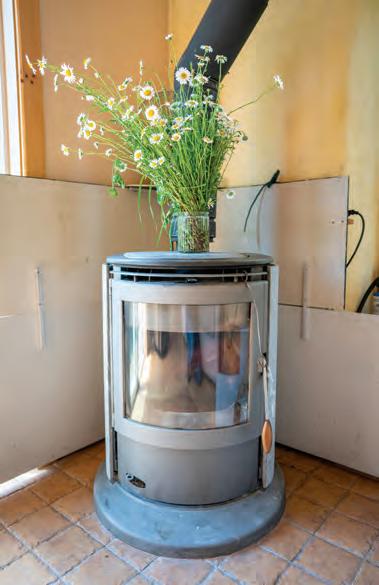



RIGHT AT HOME • FEATURE 56 MARTHA’S VINEYARD /SUMMER 2022
A stucco-like mixture finished with a pigmented lime wash covers both interior and exterior surfaces.
The Solarazzas' indoor water is heated by the sun.
straw bale homes: big hats and boots. This is why we have such big overhangs,” Emily tells me. “I also put moisture sensors in the straw so I could be alerted to any mold problems. But we have never had a problem,” Steve says. Emily continues, “Steve also made the smart choice not to put all the plumbing and electrical inside the straw, which some people do. This way, if there is a plumbing problem or electrical issue, we can address it without disrupting the home’s impermeable membrane.”
October, they had done enough work to be pretty warm inside. But, because they had put solar panels on the roof as one of their first acts, they were able to use solar panels to heat their water and power the actual build-out of their home.
Every aspect of their home is personal and comes with a story. The walls bear art by their children Siana, who is 13, and Bowen, who is 10. The bathroom sink has Sassafras leaves along with shells and seeds — given to them by friends
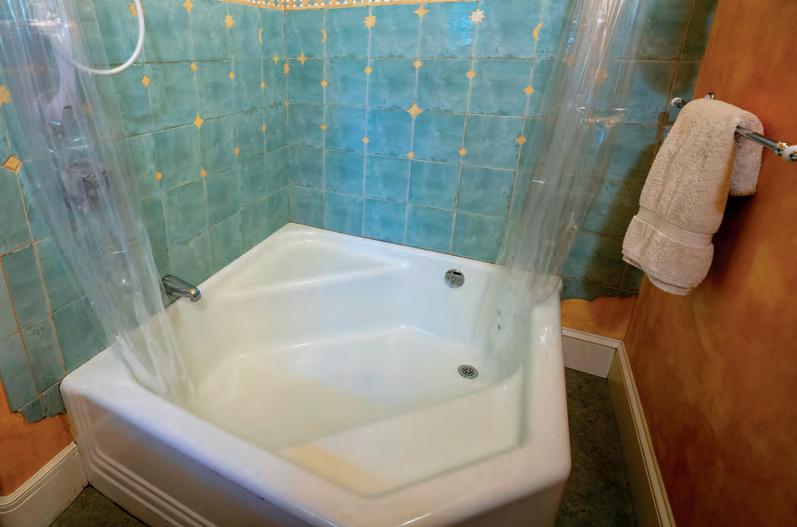
explains how they use solar hot water. She shows me a meter and reads the temperature — about 90 or so degrees. Hot enough for a shower. “We do have backup for our solar hot water heater,” she says. “Sometimes it is not [hot enough] and then I hit the switch to use electricity to heat the water,” Emily says, showing me the switch. “But usually, I’ll look at the weather and if it is going to be sunny a bit later, I’ll shower then.” She laughs, “I mean, if I have to shower, of course I will, but if there is room to wait, I’ll do that. I mean, why not use the sun when you can?”
I asked if they’d always been this committed to preserving the environment. “We like participating,” Steve says. “It feels good.”
Once the first layer of the stucco-like mixture was dry, Paul returned to the Island and their team applied another ½-inch layer of the mixture. Another month passed and they waited for the second layer to dry. Once that was finished, they used a lime wash with some pigment in it to finish the interior and exterior surfaces.
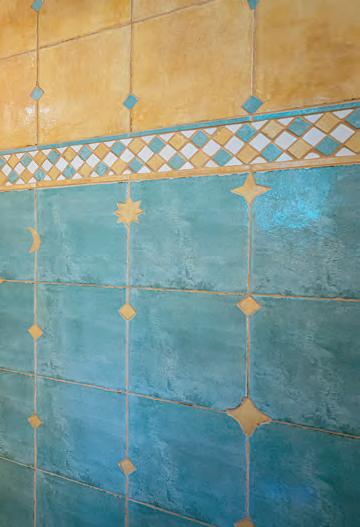
Steve and Emily moved into the rough structure in August 2005. “We were essentially camping,” Emily says. By
— sealed in epoxy. And so much of their home incorporates reused and repurposed objects. The pedestal for their bathroom sink is an old iron Singer Sewing Machine stand. They found their farmer’s kitchen sink on the side of the road in West Chop. “It’s Italian,” Steve says. Their huge bathtub was sitting on County Road. “I found it and called Steve who came to sit in it,” Emily says, laughing.
While we are in the bathroom, Emily
Emily nods. “As you can see, Steve is a bit of an inventor,” Emily says, as they show me yet another ingenious way they bring in and circulate warm air using a fraction of energy that a heater would use. Essentially, it is a box outside a window that traps warm air and moves it through a vent into the house. “He likes to figure things out.”
“I also like the fact that because we do not have huge living expenses, we both can work a bit less and can spend more time with each other and our children. I mean, for me, that’s what it is all about.”
FEATURE • RIGHT AT HOME 57 marthasvineyard. .com
Their huge bathtub was sitting on County Road. “I found it and called Steve who came to sit in it,” Emily says, laughing.
So much of the Solarazzas' home comes from reused and repurposed objects.
Room For Change:
Charge Up Your Lawn
By Mollie Doyle Photo Randi Baird
It is summer, people. Time to get outside. So I will keep it short and talk about some lawn tools you might want to consider as you head out into the sunshine.
First and foremost, let me say that I am a grass girl. I love it. And as a founding member of The Field Fund, dedicated to preserving and improving grass playing fields on Martha’s Vineyard, I know the great value of a well-maintained natural grass field or lawn and it means carbon sequestration (not nitrogen loading!!), more water retention (read: less need for irrigation), and it is also a naturally cooling surface, which is why it feels good to collapse on your lawn on a hot summer day.
Must you mow?
Second, it is, as Geraldine Brooks, fellow grass fan and Pulitzer Prize-winning
West Tisbury resident (and author of the recent, highly acclaimed novel Horse) told me, wonderful and rewarding to not mow. She wrote to me, “I am a fan of not mowing. I have returned about half of my place to meadow, which I mow just once every year or two to keep the invasives (Russian olive, mainly) away. I don't mow at all in May (#nomowmay). I stopped doing this three years ago, and every year there are more wonderful wildflowers — purple speedwell, violets, blue-eyed grass, Star of Bethlehem, crocus, paperwhites, wild sorrel — as well as interesting native grasses and sedges. The less I mow, the healthier and greener the grass looks and the longer it continues to grow before dormancy.”

In other words, less mowing means more biodiversity and more habitat for the planet’s critters and us. Less mowing is also good for the grass itself. Grass
tolerates getting its leaves clipped, but less leaf length (that is, grass that has been cut) means less photosynthesis and less energy for the plant’s roots. This is why there has been a great push for #nomowmay, as Geraldine mentioned, which is a movement that encourages those with lawns to wait a month before getting on or behind your machines. My family has begun to embrace this approach and I will say that it does make a difference in the overall health of the grass. So our first lawn rule might be to see what areas you can not mow and what areas you can mow less.
If you must mow
Nonetheless, for most, having even a little lawn around the house is a reality and at some point does need to be cut. Last June, our mowing crew got Covid. Within a week the grass around our
58 MARTHA’S VINEYARD /SUMMER 2022
Geraldine Brooks wades through her uncut grass.
If you must mow, consider going electric with mowers and blowers that do the job with less pollutants.
house and my sister’s was higher than our ankles. I knew that by the time the guys would be feeling better, the grass would be up to our knees so I borrowed my dad’s STIHL electric mower and began mowing.
Mowing is not new to me. As a teenager, I walked hundreds of miles behind a mower, working for a landscaper and mowing our family’s lawn. I dreaded it. Mostly because the mowers were so incredibly loud and I always spilled gas on my hands and shoes.
Mowing with an electric mower was an entirely different experience. No gas spills or fumes. By the way, according to the EPA, “Over 17 million gallons of gas are spilled each year refueling lawn and garden equipment — more oil than was spilled by the Exxon Valdez!” No noise. A nearly meditative experience. And using clean energy felt so much more in tune with the healthy grass I was trying to cultivate. Again, the EPA says that “one gas mower spews 88 lbs. of the greenhouse gas CO2, and 34 lbs. of other pollutants into the air every year. This, according to the Union of Concerned Scientists, means one gas mower running for an hour emits the same amount of pollutants as eight new cars driving 55 mph for the same amount of time!!
I mowed and mused, “Why are we still using something like gas — a fossil fuel — to help nature when it also works at the expense of it?” Then a friend drove by and stopped to say hi. She too has embraced electric mowing technology. She echoed my thoughts, “Given our climate change crisis, why would we be using anything but electric mowers, weed wackers, and leaf blowers?” As she drove away I wondered, “Maybe folks are still using gas mowers because they are better?”
I did some research. It turns out today’s electric machines are more effective and more powerful than any gas version. And they are cheaper in the long run — especially with today’s gas and diesel prices.
It is important to note that noncommercial grade electric mowers typically run for about an hour until the
battery runs out. My father was smart and purchased an extra battery with his STIHL mower. This made it easy to mow both my house and my sister’s in one afternoon. I charged one battery as I mowed with the other and then swapped. No matter what equipment you buy, I would strongly recommend this approach.
I look to The New York Times’ Wirecutter’s picks for 2022 mowers as I think it is a reliable resource for product recommendations. It pointed to two electric mowers:
The EGO POWER+ Select Cut 56-volt Brushless 21-in Cordless Electric Lawn Mower 7.5 Ah (Battery & Charger Included). Two blades, high powered, and intuitive. These are about $700, but no gas needed ever.
The EGO POWER+ 56-volt 21-in Cordless Electric Lawn Mower 7.5 Ah (Battery & Charger Included). These only have one blade, cannot handle big rough grass, but are more than enough for a lawn. About $500.
Another option is a robotic mower. These are electric mowers that operate much like robotic vacuum cleaners and can run for about 8 hours on a single charge. These are terrific for several reasons. First, they are super quiet. Second, they do not use gas. Nor do they need to be carted to and from your home on a weekly basis by a gas burning truck. They cut so consistently and regularly that the small clippings are left on the lawn, re-innoculating
your yard with nutrients and serving as a natural fertilizer. And they are safe around pets and little people. While these cost significantly more — anywhere from $1400 to $4000 — they make great sense for some, but do take some technological know how to set up. A wire that delineates the lawn’s perimeter must be installed, and to maintain, blades need to be sharpened — they can occasionally get hung up on a piece of lawn furniture if it is in the way. If you are not an inclined DIYer, but robotic mowing sounds appealing, you can use a robotic mowing service. Here on the Island GoGreener.us works with landscapers and homeowners to set up and maintain robotic mowers. When I talked to Go Greener Founder Adam Sloan and his associate Mike Senyszyn, Adam shared that their pricing is “comparable to a traditional mowing service.” And said that the annual cost of charging a mower is “about $8 dollars a season.” So you are getting less noise, more consistent cutting, and significantly lowering your mowing carbon footprint. Mike and Adam also have turf management teams
to come out and inspect the lawn once a week, looking for areas that might be overwatered, too dry, or have weed or fungal problems and then communicate this to your landscaper. They also have a troubleshooting team that can deal with a mower that has shut down or is stuck. Pretty cool.
Continued on page 62
FEATURE • ROOM FOR CHANGE 59 marthasvineyard. .com
“Given our climate change crisis, why would we be using anything but electric mowers, weed wackers, and leaf blowers?”
Linocut by Dan Waters
My husband, like so many North American men, loves a lush green lawn. To be fair, our culture has long groomed these men to express their sense of dominion blade by blade. Masculinity is measured in monoculture, by an ability to banish weeds and slugs and moss. Consequently, any challenge to this verdant vision generates a rapid defense. No, we cannot have a “natural” yard, these men — or my husband, at least — scoff.
What can I say? As for so many of our ridiculous customs, we can blame European aristocracy. Vast emerald lawns, for those who slept in castles, were more evidence of their wealth. A chance to make others, ahem, green with envy.
Americans spent $105 billion in 2020. No matter the ecological cost. The same article estimates the U.S. has 40 to 50 million acres of this environmental deadspace. No matter the inputs. Three trillion gallons of water, 59 million pounds of pesticides, three billion gallons of fuel for lawn maintenance, reports the Post. However, having long witnessed the financial and emotional inputs that my husband has historically sunk into creating this most unnatural of nature, I have not — will not! — give up this particular battle. I’ve simply been biding my time.
That strategy is no longer an option.
You see, my husband and I have been building a new summer home. There have been delays. And delays to our delays. A small project has become a large one. An “easy” project has become anything but. Three years later, however, the end is in sight. The solar panels are on the roof. Our septic system was installed last week. Perhaps you can hear the heartbeat of a hammer securing shingles to the outside walls.
And so my husband’s and my protracted battle about our yard is no longer hypothetical, no longer “when the time comes …” The time to dismantle the blade-iarchy is now.
We have embraced and aspired to this status symbol. This pressure is so intense that, as one study indicated, “Households make tradeoffs between lawn aesthetics and concern for the environment and exposure to chemicals in part due to strong social pressures surrounding lawn maintenance.” Put another way, we are willing to jeopardize our health and that of our planet to hew to some antiquated notion of outdoor aesthetics.
No matter the financial cost. A recent Washington Post story says lawn-loving

Please know that I am not a lawn anarchist. I grew up with the suburban ideal of a lawn. I have fond memories of lying on my back outside, grass blades tickling my feet, my best friend Cathy beside me, the two of us staring skyward and sharing imaginings of elephants and bunnies in the clouds. A lawn is an invitation to recline, to kick a soccer ball. I get that. I am not antilawn at all. I am anti-so-much-lawn. Which is my appeal to my husband: Let’s just … not have so much of it.
He points out, rightfully, that our new yard is already tiny, a chunk of a larger lot that was severed in the 1970s, right around the time I was lazing on a lawn and cloud-watching.
Exactly, I say. So let’s be creative with what little we have.
Continued on page 62
LAWN AND DISORDER • FEATURE 60 MARTHA’S VINEYARD /SUMMER 2022
A lawn is an invitation to recline, to kick a soccer ball.
I get that. I am not anti-lawn at all. I am anti-so-much-lawn.
Which is my appeal to my husband: Let’s just … not have so much of it.
By Leslie Garrett Illustration Kevin McGrath

FEATURE • LAWN AND DISORDER 61 marthasvineyard. .com
Can a couple with competing yard ideals achieve a green new deal?
Lawn and Disorder
Room for Change: Continued from page 59
If you’re a pro
For the Vineyard’s professional lawn care maintenance companies, I say, commercial grade electric mowers are also well worth investing in. I asked a number of my Field Fund contacts, including the Natural Grass Advisory Group, which advises professional teams around the world on their natural grass maintenance, and they told me Mean Green Electric Mowers (meangreenproducts.com) are standouts. Certain models can run for up to eight hours. These commercial mowers are not cheap — $23,000 to $40,000 — but the company insists the annual and five-year savings are significant — in one case, saving between $62,000 and $78,000 over five years. I also like the Gravely Pro Turn EV, which costs about $28,000 and has a striping kit.

Wack away emissions with an electric weed wacker
Popular Mechanics rates the Makita XRU15 String Trimmer with 4 Batteries
as its number one weed wacker. These are not cheap: $399. So if you are looking for a cheaper, less flashy but super effective string trimmer, Popular Mechanics rates the WORX WG163.9 Cordless String Trimmer as its runner-up. This runs about $112. Both are widely available.
Then there are leaf blowers
Finally, the ultimate noise polluter and neighborhood polarizer: the leaf
blower. Wirecutter likes the corded Toro PowerJet F700, describing it as an “air bazooka.” These cost about $70. Its top pick for a cordless leaf blower is the EGO POWER+ 56-volt 650-CFM
180-MPH Brushless Handheld Cordless Electric Leaf Blower 5 Ah (Battery & Charger Included). These cost about $279. Electric models don’t eliminate pollutants but they dramatically reduce them by putting responsibility for filtering them onto power plants. Of course, there are also rakes.
Natural Neighbors
As with everything in Room For Change, less is more. After meeting with Biodiversity Works’ Angela Luckey, who is spearheading their Natural Neighbors program, we have decided to rewild some areas of our property and cut some grassy areas just once a year rather than twice. I have to say that I can already see more bees and birds flitting about, which is pretty cool.
He casts a side-eye at me.
I know what he imagines. It’s the same thing he’s been imagining for 20 years. No matter that our off-Island property is pockmarked with patches of dirt where wasps have created subterranean surveillance. Or that it displays considerable evidence of our two large dogs (and one visiting Ukrainian dog, a Schnauzer who loves to dig). Or that it has patches of clover,
moss, butter-yellow dandelions.
Our lawn has always been thus. No matter the seeding, the aerating, the hoping. We let nature do the watering, and birds and bats do the pest control.

“I just need really good seed,” my husband says, with the earnest conviction of a junkie who is sure that this time things will be different.
It will not. Which is why I’m staging an intervention. Which is
why, if you drive by our tiny postagestamp size Vineyard lot, you will not see a blanket of green. You will see periwinkle hydrangea perfectly fed by the Vineyard’s acidic soil. You will notice clumps of wildflowers to entice butterflies. And yes, you will likely see some patchy grass, perhaps ten by ten feet. Just enough for an adolescent girl, or even a middle-aged woman, to lie on her back, look to the sky and dream.

ROOM FOR CHANGE • FEATURE 62 MARTHA’S VINEYARD /SUMMER 2022
The less I mow, the healthier and greener the grass looks and the longer it continues to grow before dormancy.
– Geraldine Brooks
The ‘ KEEP-THIS ’ Simple, Smart, Sustainable Handbook
Our full guide, which includes recycling/composting information and so much more is online at bit.ly/MV-HANDBOOK

COMMUNITY RESOURCES LIBRARY OF THINGS
At the West Tisbury Library, patrons can check out games, activities, audiovisual equipment, musical instruments, tools, and much more. Visit bit.ly/WTLIB-THINGS for a full list of items. Look for updates on other Island library "things."
MV COMMUNITY SEED LIBRARY
A collaborative project of the West Tisbury Library, Island Grown Schools, Polly Hill Arboretum, Whippoorwill Farm, and local home gardeners, the Seed Library brings the knowledge of how to save seeds back to our island community while creating a central space where seeds can be freely shared. For more info on events, follow the @mvseedlibrary Facebook page.
VOLUNTEERING POLLY HILL ARBORETUM grounds volunteers
Starting in June, volunteers are welcome to work with staff at the 70-acre West Tisbury public garden on activities like planting, pruning, weeding, and mulching. Contact Ian Jochems for more information at ian@pollyhillarboretum.org.
GLEAN WITH ISLAND GROWN INITIATIVE
Island Grown Initiative works to build a regenerative and equitable food system on Martha’s Vineyard. Volunteers can help IGI harvest fresh local produce for Islanders in need. No experience needed. Gleaning takes about two hours and volunteers may keep a share of the harvest for themselves. To sign up, go to igimvg.org/volunteer.php.
Great Pond Foundation
THE GREAT POND FOUNDATION focuses on enhancing the health of the Edgartown Great Pond. Volunteers are encouraged to assist with
Recycle, compost, volunteer, write your rep, buy secondhand.
their Ecosystem Monitoring Program and educational outreach events, aiding in water quality and biodiversity data collection, conducting surveys of pond species, helping staff with demonstrations of scientific concepts, and assisting with science communication. For updates on volunteer opportunities, email science@greatpondfoundation.org.
COMMUNITY GREENHOUSE OF MARTHA’S VINEYARD
People come to the Community Greenhouse of MV in Oak Bluffs to gather and grow food and plants and learn together. There are a range of yearround volunteer opportunities for all mobilities and levels of expertise. Volunteers can work inside and outside to help with weeding, pruning, seeding, planting, and beautifying plants; members can also pick fresh produce. For updated information, visit marthasvineyardgreenhouse.org/
SECOND-HAND STORES
CHICKEN ALLEY THRIFT SHOP
38 Lagoon Pond Rd., Vineyard Haven; chickenalley.org
MARTHA’S CLOSE:
79 Beach Rd. #9, Vineyard Haven; 508-696-5488
SECOND TREASURES MV
61 Beach Rd., Vineyard Haven; secondtreasuresmv.com
ACT TWO SECOND HAND STORE
66 Main St., Vineyard Haven; acttwosecondhandstore.org
THE 'DUMPTIQUE'
West Tisbury Transfer Station
Want something else included? Email us at editor@bluedotliving.com
‘KEEP-THIS’ SIMPLE, SMART, SUSTAINABLE HANDBOOK 63 marthasvineyard. .com
HEROES
LOCAL
Tess Bramhall and Pam Goff are committed to preserving Vineyard land.
By Julia Cooper
Tess Bramhall and Pam Goff share a passion for conserving and protecting the land of Martha’s Vineyard. Though they are each loath to accept the title of “hero,” their efforts to help protect nearly 40% of the Island’s total land area is worth celebrating.
Bramhall moved to the Vineyard in 1980 and Goff arrived in 1981. The women had become passionate about land conservation growing up and on-Island and they loved taking walks through the Island’s beautiful landscapes. As developers were rapidly subdividing land all over the Island, the women soon found their favorite trails blocked off with “private property” signs. “We probably ended up going to a lot of places that we should not have gone in those days,” Bramhall says to me as we sip iced tea in her Seven Gates home.
Goff hoped the efforts of the Vineyard Conservation Society, which had been operating on the Island since 1965, would protect and preserve the wild lands of the Vineyard. “The generations ahead of us, folks like Flora Epstein, the Harrises, Polly Hill, gave their land to be preserved,” Goff says. “You could tell that those days were coming to an end. There would have to be a way to preserve land that didn’t depend on people’s generosity.”
Goff had heard about the success of the Nantucket Land Bank in 1983: “We pricked our ears up to see how it was done — how we could get a revenue stream to buy land
and pay people what it was worth.” Prior to approving the formation of the Martha’s Vineyard Land Bank, Dukes County appointed a study committee to determine how to adapt the Nantucket Land Bank legislation for the Vineyard. Goff served on this committee and worked with tech-savvy Deborah Moore as well as the Conservation Law Foundation in Boston to draft the legislation for the Martha’s Vineyard Land Bank. What makes the Land Bank unique is the implementation of town advisory boards that empower each town’s conservation efforts by allowing Land Bank funds to move fluidly across town-lines.
The Martha’s Vineyard Land Bank has been operating since 1986 and Goff has served on the Land Bank commission ever since. She is currently serving her last term as chairman. “I’ve stayed on too long,” she says. “But it was so much fun.”
In 1997, Bramhall started the Conservation Partnership of Martha’s Vineyard with Edo Potter, Al Tilghman, and Eleanor Graves. The Conservation Partnership created a unified voice for the Sheriff’s Meadow Foundation, the Vineyard Conservation Society, The Trustees of Reservations, and The Nature Conservancy.
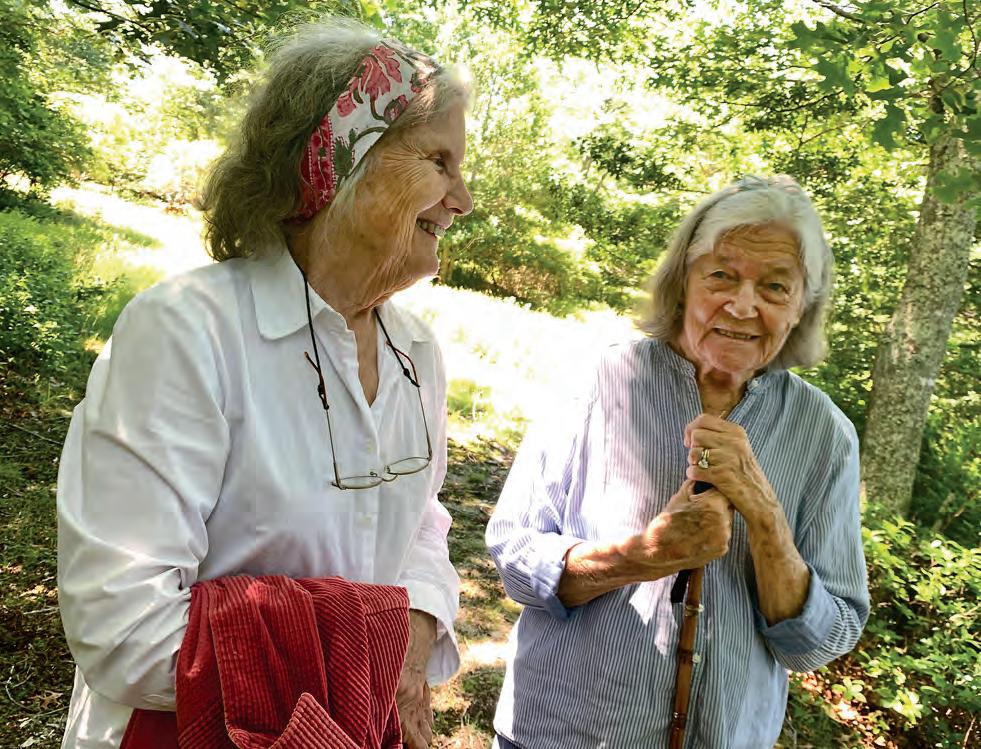
Before the Conservation Partnership, “each group worked on their own, so there was a lot of stepping on toes,” Bramhall says.
Bramhall hopes that the Land Protection Fund, a component of the Martha’s Vineyard Community Fund that she founded in 2018, will be able to serve as an example of
collaborative conservation efforts. Recently the Land Protection Fund worked with the Martha’s Vineyard Land Bank to acquire 26 acres of land along the banks of Mill Brook and Crocker Pond in West Tisbury.
In addition to her work in land conservation, Bramhall has also published two books. The first, Ty Loves Flowers, is a toddler’s environmental awareness picture book that she dedicated to her grandchildren. More recently she published In Praise of Protected Lands and Special Places on Martha’s Vineyard, which features Island properties that have become spaces for public enjoyment as well as for the conservation of natural resources.
Bramhall and Goff light up when they talk about their favorite Vineyard walking trails: Waskosim's Rock, Lucy Vincent Beach, Cedar Tree Neck, Mill Brook, the Great Ponds, and countless off-the-record locations that may or may not be officially available to the public. “My dream is that everybody should be able to step outside their house and find a beautiful place to walk,” says Goff.
Bramhall and Goff recognize that there will always be more work to be done when it comes to protecting the habitats of Martha’s Vineyard, especially as sea levels continue to rise, posing new issues for Island land conservation.
“I’m not so sure about heroes,” says Bramhall, grinning as she looks over to Goff. “Maybe something more like movers and shakers.”
LOCAL HEROES 64 MARTHA’S VINEYARD /SUMMER 2022
Pam Goff (left) and Tess Bramhall.
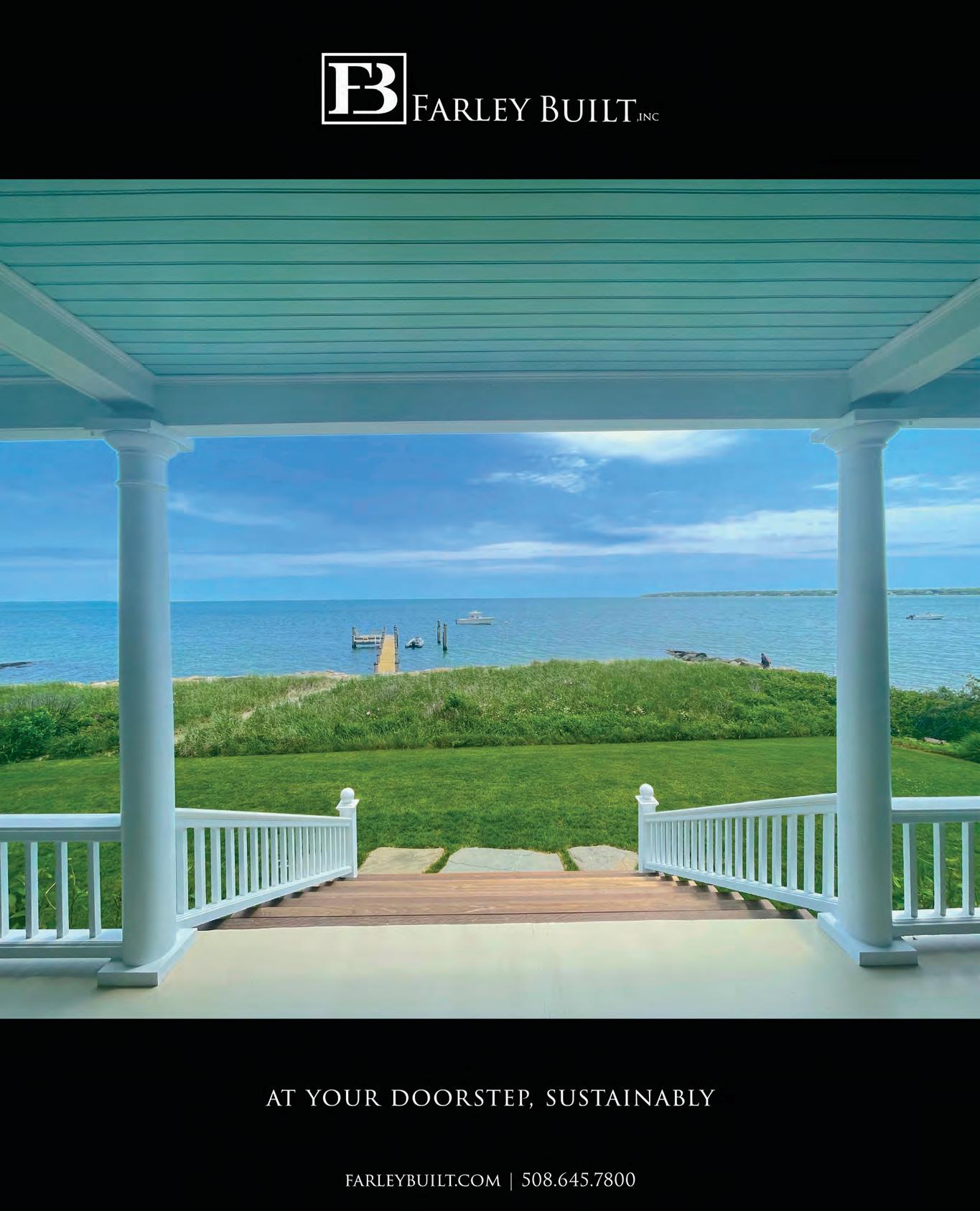


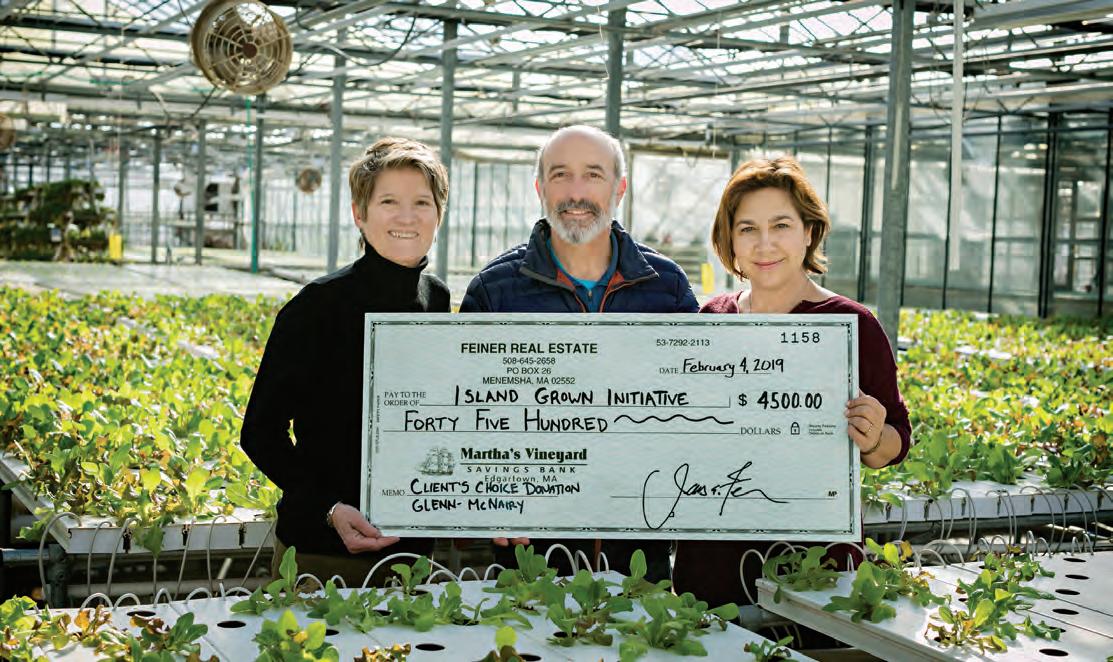
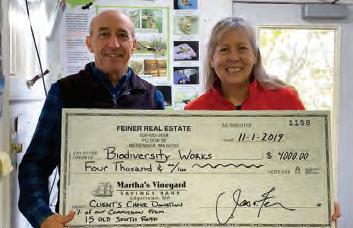


Support your favorite charity with our Client’s Choice program. 10% of every commission is donated to the charity of your choice when you buy or sell a home with Feiner Real Estate. Our program and our clients have made a huge impact by donating over $350,000 to island non-profits! Win. Win. Win. For an extra 5% off your commission, mention Bluedot Living FEINER REAL ESTATE, YOUR SOCIALLY RESPONSIBLE BROKERAGE. marthasvineyard-realestate.com · 508-645-2658 Give us a call to find out more! THANK YOU MARTHA’S VINEYARD! Island Grown Initiative Biodiversity Works Sheriff’s Meadow Foundation Felix Neck/Audubon Society














































































 –Gwyn McAllister
–Gwyn McAllister



































































































